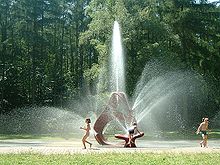List of fountains in Frankfurt am Main
This is a (partial) list of fountains in Frankfurt am Main . The city of Frankfurt has 145 fountains in municipal entertainment. In addition, former wells are shown as far as they are described in the literature. Many of the fountains are listed .
History and function of today's Frankfurt fountain
Water supply
Draw well
With the emergence of the first permanent settlement, the water from the Main and tributaries was no longer sufficient to supply the population with water and draw wells were drilled. Only a few of these wells have survived. In the Roman city there is a Roman well of the former city of Nida . A medieval draw well has been preserved at the Friedberger Warte and the Sachsenhausen observatory .
From the 16th century there was a strict regulation of the wells. For each well there was a well roll, i.e. a list of all the well neighbors who were allowed to use the well and were required to maintain it, as well as the annual fees to be paid for this ( well fee ). An older and a younger fountain master elected for one or two years each were responsible for renovating and cleaning the fountain. At some wells, a volunteer well-school hotline also monitored the activity of the well master.
In modern times, the inflow of groundwater from the wells was no longer sufficient to ensure the supply of the growing city. In 1607, under the supervision of a specially appointed citizens' commission, the construction of a water pipe began to convey the water from the springs from the Friedberger Feld in what is now Nordend , between Bornheimer Landstrasse in the north and Merianstrasse in the south, into the city. The water was extracted there in six well chambers and fed into a main line, which branched into an east and a west line approximately at the level of Eiserner Hand and Friedberger Landstrasse . These ran under the Friedberger Tor and the Eschenheimer Tor into the city and supplied around 30 urban wells here according to a pipeline plan from 1690. The pipelines were initially made of lead, later of wood and from 1771 of iron. In total, they fed around 155 cubic meters daily into the city's wells, enough to ensure the city's water supply for over 200 years.
Pump well
In the 18th and 19th centuries, the draw wells in the urban area were mostly replaced by pump wells. A typical design was created from a fountain column made of red Main sandstone and sandstone basins, as can still be found in many parts of the city.
After the Free City of Frankfurt was founded , the aqueduct from Friedberger Feld was no longer sufficient to meet the growing needs of the now approx. 41,000 inhabitants. In 1815 a second aqueduct was planned and completed in 1828–1834: Water from the Knoblauchsfeld in the north end, west of the Eckenheimer Landstrasse between today's Schwarzburgstrasse and the Falkensteiner Strasse, also supplied the city in the future. The four vaulted well chambers were connected to one another by the water gallery , an accessible, underground channel almost 500 meters long. At the same time, the sources of the Friedberger Feld were redefined and connected by a canal. A total of 17,000 meters of supply lines now led to the two distribution chambers at Friedberger and Eschenheimer Tor, which together conveyed 1500 cubic meters of spring water daily. The distribution network in the city supplied 98 pump wells and 120 tube wells, 120 fire hydrants and around 300 house nozzles. On January 1, 1832, the fountain rolls were revoked and responsibility for the municipal wells and the collection of the fountain fee was transferred to the municipal building authority.
A third aqueduct was built in Sachsenhausen from 1856 to 1859, which supplied the Sachsenhausen and Frankfurt side with 1200 to 1900 cubic meters of water from the Seehof spring every day. The necessary water pressure was generated with two steam engines of 28 HP each. A new water-powered pumping station was built on the Old Bridge for the Sachsenhausen gardeners who had previously used the Seehof spring . Until 1862 the city still levied a well fee, since then the city has borne the costs of the public wells itself.
drinking fountain
With the construction of the water network at the end of the 19th century, the wells lost their function of supplying water to the population. Nevertheless, wells were still built for water supply until the 1960s. They were drinking fountains that were open to the public. Such drinking fountains were built in particular in the schools that were newly built or restored after the Second World War . These were often artistically designed as art in architecture. Examples are the pelican fountain by the sculptor Claere Bechtel at the Albert Schweitzer School, the sea lion fountain by the Frankfurt painter and sculptor Karl Trumpfheller at the August Jasper School or the "cleaning swan" by the Frankfurt sculptor Faber-Jansen at the Else-Sander- School. These wells have almost completely disappeared today. Even with wells with spring water of drinking quality like the Röhrborn in Bergen-Enkheim, signs warn of "no drinking water" for reasons of liability.
In 2016, the first stainless steel drinking water fountain was installed on the corner of Liebfrauenstrasse and Zeil. Another one was later set up at the Alte Oper at the beginning of Freßgass and one in the water park. The operator Mainova plans to build more drinking water wells in the city area.
Healing fountain
Even if Frankfurt was never a spa , there were and still are some fountains in the city that have been and are ascribed medicinal properties.
The Grindbrunnen , already mentioned in the 13th century, was located at Gutleuthof in today's Gutleutviertel . It was a popular destination on the outskirts of the city. Goethe described the goings-on in his memoirs:
“On the right bank of the Main below, about half an hour from the gate, there is a sulfur well, neatly bordered and surrounded by ancient linden trees. Not far from there is the "Court of the Good People", once a hospital built for this spring's sake. On a certain day of the year the herds of cattle from the neighborhood gathered around on the communal pastures, and the shepherds and their girls celebrated a rural festival, with dancing and singing, with all kinds of lust and naughtiness. "
In 1868, the Frankfurt national poet Stoltze ironically sang about the olfactory effect of a romantic walk to the Grindbrunnen:
"The night air brought us out of the promenade, a fragrance like hair oil and bommad , like köllisch water and like musk pills ."
The meadows around the Grindbrunnen served the Frankfurt vigilante groups as a parade ground in the 19th century , where they always gathered on the anniversary of the Battle of the Nations near Leipzig . The sulfur- and sodium-containing water has healing properties for skin diseases, hemorrhoids , gout , rheumatism and even all kinds of mental illnesses . However, patients were advised not to drink more than five jugs a day. In 1873 a drinking hall for spa guests was built. In 1875 a committee was even founded to raise Frankfurt to a spa town and to rename it to Bad Frankfurt . In 1886, due to the expansion of the western harbor , the well was relocated to Nice , where a similar spring had been drilled. However, the well proved to be insufficiently productive and the spa operation was terminated before 1914. In 1963 the well was closed permanently due to groundwater pollution.
In Sossenheim and Nied there are several wells that are geologically the continuation of the spring area, which stretches down from the Kronthal spring park via Bad Soden am Taunus to the Main. These include the Faulbrunnen in Sossenheim and the Selzerbrunnen as well as the Faulbrunnen in Nied.
The Königsbrünnchen is located in the Frankfurt city forest near the Jacobiweiher . The light brown color of the well water comes from iron oxide hydrate, the water is said to have healing properties. It tastes slightly like hydrogen sulfide.
Ornamental fountain
Since the beginning of modern times, representative fountains have been built especially in central places such as Römerberg, Kaiserstraße, in front of the zoo or Landgrafenplatz, which were supposed to document the status and wealth of the city.
Well axis
With the local elections in Hesse in 1977 , in which Walter Wallmann (CDU) was elected mayor in Frankfurt , a clear change in urban development began. In addition to investments in cultural objects (reconstruction of the old opera , museum bank ), the idea of a fountain axis was also part of the reorientation of city policy. The Lucae fountain at the old opera, the Freßgass fountain, the Struwwelpeter fountain at the Hauptwache, the Pomodoro fountain and the Brockhaus fountain on the Zeil were built. The expense of over 5 million marks was used to upgrade the Zeil and Freßgass , which became pedestrian zones after the construction of the subway .
Skyscrapers and fountains
A large number of high-rise buildings have been built in Frankfurt since the Second World War . The necessary distances to the neighboring buildings created urban open spaces, which in many cases were built on with wells. Examples are the (former) fountain in front of the BfG high-rise , the fountain behind the Dresdner Bank high-rise or the high-rise in the park .
A particularly large water system is located in the shaft . The publicly accessible promenade with an artificial watercourse, which is intended to remind of the former course of the Leerbach, runs between the two components. Individual sections are equipped with bubbles.
Water playgrounds
There are 7 forest playgrounds in the Frankfurt city forest, some of which are equipped with paddling pools and water spraying systems by the forestry office. The spray fountains are partially equipped with fantasy figures by the sculptor Hugo Uhl . Comparable spray fountains can be found (in the order in which they are created) in the Schwanheimer Waldspielpark, in the Höchst City Park, in the Eschersheim outdoor pool and in the Tannenwald forest recreation park. Not all systems have been preserved.
In the urban area, the garden department has also set up water playgrounds in various parks. One example is the water playground in Günthersburgpark . In 2013 a new water playground was built in Niddapark for € 500,000 .
The fountain festival
The fountain festival in Sachsenhausen was first mentioned in a document in 1490. It is celebrated every year on the 3rd weekend in August. It is particularly important for the Frankfurt fountains that the fountain festival has been used as an occasion to renovate or create new fountains since the 1950s. This resulted in a large number of fountains in the Sachsenhausen district. One of the most famous fountains is Frau Rauscher's fountain in Klappergass.
In 1961 this fountain was inaugurated by the fountain queen Helga I. The specialty of this fountain is that the figure of Mrs. Rauscher spits on passers-by walking by.
List of existing Frankfurt fountains
| image | Surname | District | location | annotation |
|---|---|---|---|---|
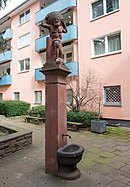 more pictures |
Atlas fountain | Frankfurt old town | Weckmarkt behind 2 50 ° 6 ′ 36 ″ N, 8 ° 41 ′ 8 ″ E is a listed building |
Classicist pump well around 1780 with an atlantic figure by Johann Michael Datzerath. The fountain replaced the fountain on the White Angel. This draw well was named after the neighboring Weißer Engel inn . |

|
Bethmann Bank | Frankfurt old town | Bethmannstrasse 50 ° 6 ′ 37 ″ N, 8 ° 40 ′ 45 ″ E |
There is an ornamental fountain in the inner courtyard of the Bethmann Bank building complex on Bethmannstrasse. |
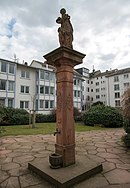 more pictures |
Freedom fountain | Frankfurt old town | Große Fischergasse / Hinterhof Am Weckmarkt 17 50 ° 6 ′ 36 ″ N, 8 ° 41 ′ 8 ″ E |
The Freiheitsbrunnen has been known since the first half of the 14th century and was called Friedhofborn, Freythofborn, Freytborn, Freitbrunnen and Freibrunnen. On April 12, 1696, a maid was executed for the murder of her newborn child, whom she had thrown into the well on February 4, 1696. In 1759, the draw well was converted into a pump well. Of the two pump columns made of red Main sandstone, one column has remained. The fountain column is crowned by a goddess of freedom created by the sculptor Johann Michael Datzerath . The fountain was on the chicken market until 1895 . It was erected on Roseneck in 1904 and moved to its current location when it was rebuilt in 1952. |
 more pictures |
Justice fountain or Römerberg fountain | Frankfurt old town |
Römerberg 50 ° 6 ′ 37 ″ N, 8 ° 40 ′ 56 ″ E is a listed building |
Fountain from 1611. |

|
Goethe House | Frankfurt old town | Front courtyard of the Goethehaus, Großer Hirschgraben 23 50 ° 6 ′ 40 ″ N, 8 ° 40 ′ 40 ″ E |
In the forecourt of the Goethe House there is a fountain with an inscription on the outside wall of the house. |
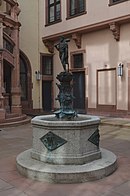
|
Hercules fountain | Frankfurt old town | Limpurgergasse 2 (Römerhöfchen) 50 ° 6 ′ 37 ″ N, 8 ° 40 ′ 53 ″ E Monument protection |
Ornamental fountain of the New Renaissance from 1904 based on a design by Joseph Kowarzik ; Allegorical reliefs on an octagonal basin , a bronze statue on an axial well. |
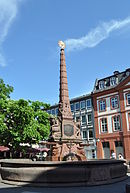 more pictures |
Fountain on the Liebfrauenberg | Frankfurt old town |
Liebfrauenberg 50 ° 6 ′ 45 ″ N, 8 ° 40 ′ 53 ″ E Monument protection |
The fountain, created in 1770 by Johann Michael Datzerath , was restored in 1970 by Kurt Zobel. |
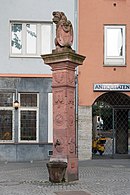
|
Lion fountain | Frankfurt old town | Tramway 27 50 ° 6 ′ 42 ″ N, 8 ° 41 ′ 10 ″ E Monument protection |
In the Middle Ages, the Grabborn fountain on the “Auf dem Grabborn” street was used as a draw well. In 1598 it was rebuilt. It was then a classicist pump well based on a design by Johann Leonhard Aufmuth made of sandstone pillars with a shield-reinforced lion, relief decoration and basin. Until the Second World War it stood on the square at An der Zange in Fahrgasse. |

|
Mägdleinbrunnen | Frankfurt old town | Untermainkai 4 50 ° 6 ′ 29 ″ N, 8 ° 40 ′ 37 ″ E |
Classicist pump fountain with a putto-like statue of a girl, stood on a Degussa building from 1912 (Alte Mainzer Gasse 64) until the Second World War . |
 more pictures |
Minervabrunnen (also: Saturday Mountain Fountain) | Frankfurt old town |
Römerberg 50 ° 6 ′ 38 ″ N, 8 ° 40 ′ 57 ″ E |
The fountain created by Friedrich Schierholz was destroyed in 1944. The reconstruction took place in 1983 after a historically accurate copy. |
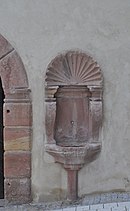
|
Shell fountain | Frankfurt old town | Buchgasse 3 50 ° 6 ′ 33 ″ N, 8 ° 40 ′ 46 ″ E is a listed building |
Shell fountain on a Renaissance octagonal tower with portal arcades |
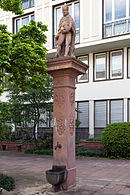
|
Schöppenbrunnen | Frankfurt old town | Fried-Luebbecke-Anlage 50 ° 6 ′ 41 ″ N, 8 ° 41 ′ 3 ″ E Monument protection |
Late Baroque pump fountain from 1776 based on a design by Johann Michael Datzerathaus Sandstone pillars with rococo reliefs , a basin in front and an emperor's statue (presumably Joseph II ). The fountain was on the Krautmarkt until the Second World War. Originally there was an open draw well, the "Wobelinsborn" or "Weibleinsbrunnen" at the place. |

|
Seal fountain | Frankfurt city center | Schäfergasse 50 ° 7 ′ 1 ″ N, 8 ° 41 ′ 4 ″ E Monument protection |
Drinking fountain for the students of the Liebfrauenschule from 1954 based on a design by Edwin Hüller made of shell limestone. The fountain is in the school yard and served the schoolchildren to quench their thirst, so there were often ladles on the sides. On the fountain basin with six columns, Hüller placed a plinth with a one meter high fountain figure made of shell limestone. There two seals sit upright opposite each other on a ball and juggle a ball on their noses. Today the fountain basin is no longer filled with water and is now planted with flowers. |

|
Stoltze fountain | Frankfurt old town |
Hühnermarkt 50 ° 6 ′ 39 ″ N, 8 ° 41 ′ 4 ″ E is a listed building |
Neo-Renaissance monument based on a design by Friedrich Schierholz for the poet Friedrich Stoltze (1816–1891); Tiered structure with a water basin, a sandstone fountain in relief and a bronze bust (partly a copy). As of 1981 to 2016 on Friedrich-Stoltze-Platz behind the Katharinenkirche . |
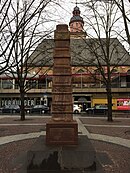
|
White Lily Fountain | Frankfurt city center | Katharinenpforte 50 ° 6 ′ 45 ″ N, 8 ° 40 ′ 47 ″ E Monument protection |
In 1390 a draw well is mentioned for the first time on today's Rathenauplatz. In the end, it was a free-standing, roofed draw well at the entrance to Freßgass , which was named after the neighboring house "To the white lily". In 1794 the sculptor Johann David Voelcker created a classicist pump well. The cost of more than 942 guilders shows the effort that was made: The more than 8 meter high well consisted of a well basin with four columns. These pillars were crowned by an obelisk with a vase and a golden lily. In 1831 the well was demolished and its parts sold. The obelisk has been preserved and has been on Friedrich-Stoltze-Platz behind the Katharinenkirche since November 2017 . |

|
Fountain and water wall at Jürgen-Ponto-Platz | Frankfurt-Bahnhofsviertel | Jürgen-Ponto-Platz 50 ° 6 ′ 33 ″ N, 8 ° 40 ′ 9 ″ E |
On June 10, 1980, an ensemble designed by Prof. Heinz Mack was inaugurated on the open space created by the construction of the Dresdner Bank skyscraper , Jürgen Ponto Square . A circular well with a diameter of 16 meters sunk into the ground is covered by a film of water. Next to it is a 9 meter high wall of water from which the water cascades down. |

|
Main Forum fountain | Frankfurt-Bahnhofsviertel | Wilhelm-Leuschner Strasse 50 ° 6 ′ 11 ″ N, 8 ° 39 ′ 58 ″ E |
As part of the construction of the Main Forum , a fountain system consisting of two basins was created. |

|
Günthersbrunnen | Frankfurt-Bergen-Enkheim | In front of the half-timbered house no. 23 50 ° 9 ′ 23 ″ N, 8 ° 45 ′ 16 ″ E is a listed building |
The "Günthersbrunnen" is a baroque well from the 17th century, walled with Vilbel sandstone, which was renewed in the 18th century. The limestone shaft is 16 to 25 meters deep. |

|
Michlersbrunnen | Frankfurt-Bergen-Enkheim | At Michlersbrunnen in front of house no. 13 north of Marktstrasse 50 ° 9 ′ 23 ″ N, 8 ° 45 ′ 21 ″ E Monument protection |
The "Michlersbrunnen" is a baroque fountain from the 17th century, walled with Vilbel sandstone, which was renovated in the 18th century. The limestone shaft is 20 meters deep. |
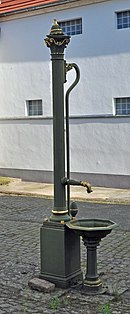
|
At Michlersbrunnen 4 | Frankfurt-Bergen-Enkheim | At Michlersbrunnen 4 50 ° 9 ′ 23 ″ N, 8 ° 45 ′ 20 ″ E |
There is a pump well in the courtyard of the Am Michlersbrunnen 4 property. |

|
Röhrborn | Frankfurt-Bergen-Enkheim | Riedstrasse, corner of Röhrborngasse 50 ° 8 ′ 58 ″ N, 8 ° 45 ′ 21 ″ E Monument protection |
The Röhrborn is described as a fountain with a stone column and two stone basins as early as 1827. In 1966/67 it was damaged as part of a road renovation and moved to its current location. The pools were renewed from red sandstone. |

|
Still well | Frankfurt-Bergen-Enkheim | Bergen, Heimatmuseum (old town hall) 50 ° 9 ′ 19 ″ N, 8 ° 45 ′ 13 ″ E |
The still well at “Peter Stills House” in Marktstrasse was a draw well from the 17th century. The fountain stood by the Schelmenburg and was moved in 2001 in front of the Bergen Local History Museum (old town hall). |
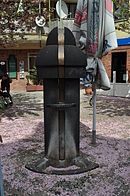
|
Basalt or drinking water wells | Frankfurt-Bockenheim | Corner of Leipziger Strasse, Basaltstrasse and Grempstrasse 50 ° 7 ′ 26 ″ N, 8 ° 38 ′ 27 ″ E |
In 1985/86 the basalt fountain was created by the Frankfurt sculptor Eberhard F. Gutberlet. The 2.15 meter high "basalt or drinking water fountain" consists of a central part cast from bronze and is otherwise made of basalt. |

|
Bleidenbrunnen | Frankfurt-Bockenheim | in front of the former Landhaus Passavant on Ginnheimer Strasse 50 ° 7 ′ 35 ″ N, 8 ° 38 ′ 20 ″ E is a listed building |
Bleidenbrunnen with pump handle, red sandstone, 1777, comes from the village history of Bockenheim |

|
Fountain Bockenheim Campus | Frankfurt-Bockenheim |
Westend campus 50 ° 7 ′ 10 ″ N, 8 ° 39 ′ 8 ″ E |
After the Bockenheimer Dandelion Fountain was moved to the Westend campus in 2008 , a fountain was installed on the old location on the Bockenheim campus . |

|
Elisabethen Hospital | Frankfurt-Bockenheim | Ginnheimer Strasse 50 ° 7 ′ 36 ″ N, 8 ° 38 ′ 20 ″ E |
Water feature, fountain in the park area of the St. Elisabeth Hospital |
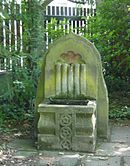
|
Fountain in the New Bockenheimer Friedhof | Frankfurt-Bockenheim |
New Bockenheim Cemetery Monument protection |
Small fountain made of red sandstone in restrained forms of Art Nouveau on the border between 8a and 3t. |
 more pictures |
Kurfürstenbrunnen or Obeliskbrunnen | Frankfurt-Bockenheim |
Kurfürstenplatz 50 ° 7 ′ 15 ″ N, 8 ° 38 ′ 33 ″ E is a listed building |
The monumental fountain in the center of the Kurfürstenplatz was built in 1913 from red Main sandstone and inaugurated on May 23, 1914. It is a foundation of the citizens of Bockenheim. Its architect was Prof. Caspar Lennartz (1879–1949) and the Frankfurt sculptor Emil Hub (1876–1954). |

|
Friedrich-Ebert-Anlage | Frankfurt-Bockenheim | Exhibition circle 50 ° 6 ′ 50 ″ N, 8 ° 39 ′ 8 ″ O |
In the center of the fair circle in the middle of a larger pond there is a fountain with a meter high fountain. |
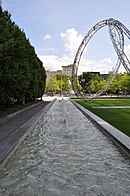
|
Castor and Pollux | Frankfurt-Bockenheim | Unit square 50 ° 6 ′ 40 ″ N, 8 ° 39 ′ 17 ″ E |
An oval fountain has been laid out around the light sculpture “Synergie” by Swiss artist Christian Herdeg . |

|
Poseidon fountain | Frankfurt-Bockenheim | Theodor-Heuss-Allee 2, Ffm-Bockenheim 50 ° 6 ′ 50 ″ N, 8 ° 38 ′ 58 ″ E |
Poseidon fountain with trident, 1986, 6 m high bronze by the Dutchman Jits Bakker in front of the house of the same name; |

|
Luisenhof fountain | Frankfurt-Bornheim | Weidenbornstrasse 40 50 ° 7 ′ 55 ″ N, 8 ° 42 ′ 24 ″ E |
In the courtyard of the FES headquarters in the Luisenhof there is a fountain obelisk (not open to the public) from the years 1864–1866. |

|
Friedberger waiting | Frankfurt-Bornheim | to the right of the entrance to Friedberger Warte 50 ° 8 ′ 26 ″ N, 8 ° 41 ′ 57 ″ E |
On the wall of the Friedberger Warte walled draw well made of natural stone and red sandstone, covered with a conical roof made of wood. |

|
Bornheim cemetery | Frankfurt-Bornheim | Well in the Gewannkreuz, tub B and C 50 ° 8 ′ 12 ″ N, 8 ° 42 ′ 12 ″ E |
Cylindrical sandstone stele on a square, stepped base with urn attachment as the crowning of a fountain basin from the 1950s. Is under monument protection. |

|
Bornheim cemetery | Frankfurt-Bornheim | Well in Gewann D on the wall 50 ° 8 ′ 12 ″ N, 8 ° 42 ′ 11 ″ E |
With a gable-like, curved attachment. The front is decorated with two vertical, stylized braided ribbons. Is under monument protection. |

|
High Fountain (Frankfurt-Bornheim) | Frankfurt-Bornheim | Berger Straße / Alt Bornheim 50 ° 7 ′ 43 ″ N, 8 ° 42 ′ 41 ″ E Monument protection |
The high fountain is an obelisk fountain made of red sandstone and was drilled in 1827 as the fifth fountain in the town to supply water. |
| Fountain at the Bornheimer Friedhof I: | Frankfurt-Bornheim | Bornheim cemetery Monument protection |
Fountain in the Gewannkreuz: Cylindrical sandstone stele on a square, stepped base with an urn attachment to crown a fountain basin from the 1950s at the intersection of tubs B and C. | |
| Fountain at the Bornheimer Friedhof II: | Frankfurt-Bornheim | Bornheim cemetery Monument protection |
Fountain with a gable-like, curved attachment, the front decorated with two vertical, stylized braided ribbons. Around 1905 | |
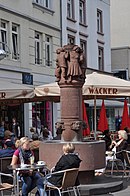
|
Reichsdorf-Bornheim fountain | Frankfurt-Bornheim | Berger Strasse 50 ° 7 ′ 32 ″ N, 8 ° 42 ′ 25 ″ E |
The Reichsdorf-Bornheim-Brunnen was designed in 1983 by Edwin Hüller , it reminds of the incorporation of Bornheim into Frankfurt. It consists of a three-meter-high column of fountain made of red sandstone. Four heads spew water into a basin. A group of figures made up of men and women, hooking each other in a dance, crowns the fountain. The fountain replaced the New Arnsburger Brunnen (see there) |

|
Fountain at the White Stone | Frankfurt-Eschersheim | White stone 50 ° 9 ′ 25 ″ N, 8 ° 39 ′ 24 ″ E |
Fountain with Hercules statue at the White Stone in Eschersheim, material: shell limestone, built: 1910 as a war memorial |
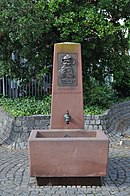
|
Jean Pauli Fountain | Frankfurt-Fechenheim | Linneplatz 50 ° 7 ′ 21 ″ N, 8 ° 46 ′ 18 ″ E |
The "Jean Pauli Fountain" from 1980 by the Fechenheim stonemason and master sculptor Siegfried Schugar is a reminder of the pedagogue and composer Jean Pauli . It is a square obelisk made of red sandstone behind a sandstone basin. |

|
Barrel Night Fountain | Frankfurt-Heddernheim | H.-P.-Müller-Platz 50 ° 9 ′ 42 ″ N, 8 ° 38 ′ 56 ″ E |
In 1989 the Fassnachtsbrunnen was installed at the Heddernheim subway station. The concrete fountain with small bubbles is dominated by the figure of the barrel night jester. The fountain was a gift from the Lurgi company on the 150th anniversary of the Klaa Pariser Fassnacht. |

|
Heddernheimer community pump | Frankfurt-Heddernheim | Alt Heddernhaim 47 50 ° 9 ′ 28 ″ N, 8 ° 38 ′ 55 ″ E is a listed building |
It is a classical sandstone pillar from 1839 with a basin on a cube-shaped base; it is crowned by a sandstone ball. The fountain is the starting point for the carnival parade in Klaa Paris every year . The side handles at different heights also made it possible for children to pump. |

|
Well in the NWZ | Frankfurt-Heddernheim |
Northwest center 50 ° 9 ′ 26 ″ N, 8 ° 38 ′ 1 ″ E |
Inside the north-west center there is a fountain with several bubbles. |

|
Roman fountain | Frankfurt-Heddernheim | Below the circular wall in Heddernheim 50 ° 9 ′ 16 ″ N, 8 ° 38 ′ 39 ″ E |
Roman well of the then city of Nida . |
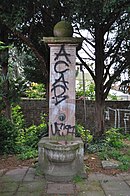
|
Fountain in the monastery garden | Frankfurt-Heddernheim | Playground in the park on Alt-Heddernheim street 50 ° 9 ′ 29 ″ N, 8 ° 38 ′ 55 ″ E |
The classicist pump fountain from 1840 with a square fountain column made of red sandstone, on the frieze of which there is a ball. |
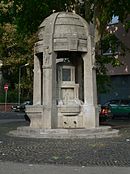 more pictures |
Brüningbrunnen | Frankfurt-Höchst | North-east corner of Höchst Markt 50 ° 6 ′ 0 ″ N, 8 ° 32 ′ 46 ″ E is a listed building |
Created in 1910 by the sculptors Johann Belz and Ph. Hermann Leonhard according to the plans of the architect Karl Wach . |
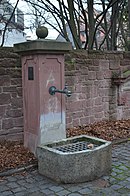
|
Dalberg fountain | Frankfurt-Höchst | between Dalberg house and swimming pool 50 ° 5 ′ 55 ″ N, 8 ° 32 ′ 45 ″ E |
Founded in 1977 by the citizens' initiative Höchst Altstadt. |
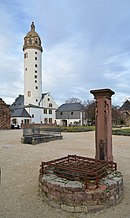
|
Castle fountain Höchst | Frankfurt-Höchst | between Castle and Main 50 ° 5 ′ 52 ″ N, 8 ° 32 ′ 50 ″ E |
In the castle courtyard there is an ensemble of a draw well and a pump well made of red Main sandstone |

|
Highest Schlossplatz fountain | Frankfurt-Höchst | Schlossplatz in front of house number 9 50 ° 5 ′ 55 ″ N, 8 ° 32 ′ 52 ″ E is a listed building |
Draw well |

|
Seilerbrunnen | Frankfurt-Höchst | Between the train station and Dalbergplatz 50 ° 6 ′ 9 ″ N, 8 ° 32 ′ 43 ″ E Monument protection |
Created in 1926 according to the plans of the Frankfurt sculptor Paul Seiler . |
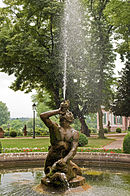
|
Triton fountain in the Bolongaro garden | Frankfurt-Höchst |
Bolongarogarten 50 ° 6 ′ 3 ″ N, 8 ° 33 ′ 10 ″ E |
In 1909 the “Triton Fountain” by the Frankfurt sculptor Josef Keller was created. The neo-baroque ornamental fountain with a round water basin is dominated by a lying dolphin on which a water-spouting triton rides. |
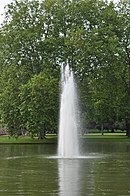
|
Fountain in the Höchst city park | Frankfurt-Höchst | Stadtpark Höchst 50 ° 6 ′ 30 ″ N, 8 ° 33 ′ 20 ″ E is a listed building |
There is a fountain in the larger of the two ponds in the Höchst City Park. |

|
Water dragons in the Bolongaro garden | Frankfurt-Höchst |
Bolongarogarten 50 ° 6 ′ 2 ″ N, 8 ° 33 ′ 10 ″ E |
|

|
James Fountain | Frankfurt-Harheim |
Bolongarogarten 50 ° 10 ′ 56 ″ N, 8 ° 41 ′ 33 ″ E |
On the occasion of the 1200th anniversary of the Harheim district in Frankfurt on May 25, 1986, the fountain was created from red sandstone by Reiner Uhl . |

|
Roman fountain | Frankfurt-Harheim | Keltenstrasse 50 ° 11 ′ 7 ″ N, 8 ° 42 ′ 1 ″ E |
The fountain was first mentioned in 1339 as “Wydeborne” (Weidenborn) but is older. It was located on the common pasture of the communities Harheim, Vilbel and Massenheim. The name Römerbrunnen has been used since 1931. |
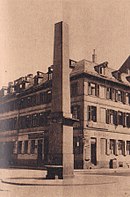
|
Brückhofstrasse fountain | Frankfurt city center | Brückhofstrasse 50 ° 6 ′ 37 ″ N, 8 ° 41 ′ 22 ″ E is a listed building |
At the instigation of Mayor Jacob Guiollett , the fountain was built in 1812 as a pump well. GW Mayr created a narrow sandstone obelisk with a winged sun disk over the fountain basin for 650 guilders. The picture shows a historical photo from before 1921. |
 more pictures |
Brockhaus fountain | Frankfurt city center | Junction of Zeil and Hasengasse 50 ° 6 ′ 52 ″ N, 8 ° 41 ′ 0 ″ E |
In 1983 and 1984, Professor Lutz Brockhaus created the Brockhaus fountain from a 38-ton block of Carrara marble. |

|
Fountain in front of the Deutsche Bank | Frankfurt city center | In front of the double tower of Deutsche Bank 50 ° 6 ′ 50 ″ N, 8 ° 40 ′ 7 ″ E |
In 2012, a fountain system consisting of two triangular, overlapping water surfaces was created in front of the double tower of Deutsche Bank. Water gushing from crevices flows over the triangular areas. |

|
Fountain in the Dominican monastery | Frankfurt city center | Kurt-Schumacher-Strasse 23 50 ° 6 ′ 43 ″ N, 8 ° 41 ′ 14 ″ E |
In the courtyard of the cloister of the former Dominican monastery there is a fountain |

|
Hauptwache (Frankfurt am Main) | Frankfurt city center | Hauptwache 50 ° 6 ′ 49 ″ N, 8 ° 40 ′ 44 ″ E is a listed building |
The Goldene - or Hauptwache-Brunnen is a pump well made of basalt and sandstone from the time around 1800. It was set up on October 4th, 1969 next to the Hauptwache |
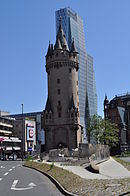
|
Goepfert fountain | Frankfurt city center | In front of the Eschenheim Tower 50 ° 7 ′ 2 ″ N, 8 ° 40 ′ 46 ″ E |
The tapering traffic island behind the Eschenheimer Tower, which emerged after the construction of the subway, was designed in 1967-1970 by the painter and object artist Hermann Göpfert with a kinetic fountain system. The lake-like fountain sculpture, 50 m long, 14 m wide and aluminum walls up to 2.50 m high, is equipped with five rotating rotors through which the water flows into the basin. |
 more pictures |
Kaiserplatz fountain | Frankfurt city center |
Kaiserplatz 50 ° 6 ′ 38 ″ N, 8 ° 40 ′ 31 ″ E Monument protection |
The Kaiserplatzbrunnen or Kaiserbrunnen consists of a large fountain basin with a goblet-like fountain pillar with a bowl. The polished bowl, from which a fountain rises, is cut from a piece of porphyry . It is a foundation of the Frankfurt banker Raphael von Erlanger from 1876 and was inaugurated together with the Frankfurter Hof opposite . |
 more pictures |
Fountain in the Rechneigrabenweiher | Frankfurt city center | Obermainanlage 50 ° 6 ′ 41 ″ N, 8 ° 41 ′ 37 ″ E |
There is a large fountain in the accounting pond in the Obermainanlage. |

|
Well in front of Taunusanlage 3 | Frankfurt city center | in front of Taunusanlage 3 50 ° 6 ′ 39 ″ N, 8 ° 40 ′ 13 ″ E |
In front of the listed building Taunusanlage 3 there is a well system. |
 more pictures |
Frankfurt fairytale fountain | Frankfurt city center | next to the new theater, 50 ° 6 ′ 29 ″ N, 8 ° 40 ′ 26 ″ E is a listed building |
On behalf of the art patron Leo Gans, the sculptor Friedrich Christoph Hausmann designed this Art Nouveau fountain, which was inaugurated in 1910 |

|
Medusa fountain | Frankfurt city center | Bürgergarten in the Eschersheim facility 50 ° 7 ′ 5 ″ N, 8 ° 40 ′ 51 ″ E |
The Medusa fountain consists of an upper basin from which the water flows through two spouting grotesque heads over a Medusa head into a lower basin in the underground garden (Bürgergarten). The fountain was built from spoils from the “Löwenstein'schen Palais” in the Taunusanlage. |
 more pictures |
Freßgassbrunnen | Frankfurt city center | Freßgass 50 ° 6 ′ 52 ″ N, 8 ° 40 ′ 30 ″ E |
The Freßgassbrunnen was created in 1977 by the Frankfurt sculptor Inge Hagner . It is a 21 × 23 meter large, accessible fountain that is integrated into the pavement and wave-shaped elevations made of granite over which the water flows into the basin. |

|
Gutenbergbrunnen (also Roßmarkbrunnen) | Frankfurt city center |
Roßmarkt 50 ° 6 ′ 44 ″ N, 8 ° 40 ′ 35 ″ E is a listed building |
The 'Johannes Gutenberg Memorial' on the southern Roßmarkt is a fountain created between 1854 and 1858 by the sculptor Eduard Schmidt von der Launitz . |

|
Marshall fountain | Frankfurt city center | Bockenheimer Anlage 50 ° 6 ′ 52 ″ N, 8 ° 40 ′ 16 ″ E Monument protection |
On October 27, 1963, the Marshall Fountain was unveiled in front of the Alte Oper in memory of George C. Marshall . The work by the Munich sculptor Toni Stadler , financed by donations from Frankfurt companies, shows the three graces Aglaia , Hegemone and Euphrosyne as symbols of giving, taking and thanking. 1970 to 1981 the monument was temporarily dismantled due to the construction of the S-Bahn . |

|
Fountain at the Nebbian garden house , also Renaissance fountain or fountain at Villa Andreae | Frankfurt city center |
Bockenheimer Anlage 50 ° 7 ′ 3 ″ N, 8 ° 40 ′ 36 ″ E Monument protection |
In 1952 the Italian Renaissance marble fountain, which had previously stood in the Villa Waldfried of the Frankfurt entrepreneur Carl von Weinberg, who was persecuted by the National Socialists, was installed at the Nebbienschen garden house. |

|
Fountain on the left side of the Nebbienschen garden house | Frankfurt city center |
Bockenheimer plant 50 ° 7 ′ 3 ″ N, 8 ° 40 ′ 35 ″ E |
Round fountain with wrought iron superstructure. |
| Fountain in the Albert-Mangelsdorff-Weiher | Frankfurt city center |
Bockenheimer plant 50 ° 7 ′ 0 ″ N, 8 ° 40 ′ 32 ″ E |
There is a large fountain in the eastern area of the Albert-Mangelsdorff-Weiher in the Bockenheimer Anlage. | |
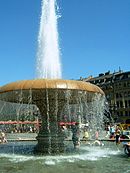
|
Opera Square Fountain | Frankfurt city center | Opernplatz 50 ° 6 ′ 55 ″ N, 8 ° 40 ′ 18 ″ E |
The fountain on Opernplatz was designed in 1872 by the architect Richard Lucae (1829–1877) and was originally intended for the Rahmhof (near Schillerstrasse). In 1983, the sketch was implemented by the sculptor Edwin Hüller from Reinersreuther noble yellow granite weighing 120 tons and inaugurated on June 14, 1983. The basin of the fountain has a diameter of 17 m, the bowl measures 5 m in diameter and has a height of 3.20 m |

|
Fountain to the right and left of the old opera | Frankfurt city center | Opernplatz 50 ° 6 ′ 56 ″ N, 8 ° 40 ′ 21 ″ E |
To the right and left of the Alte Oper there are two identical fountains that represent scaled-down models of the Lucae fountain. |

|
Struwelpeterbrunnen | Frankfurt city center | Hauptwache 50 ° 6 ′ 50 ″ N, 8 ° 40 ′ 43 ″ E |
The Struwwelpeterbrunnen made of bronze was designed by Franziska Lenz-Gerharz in 1985 and depicts a large number of characters by the children's book author Heinrich Hoffmann . |
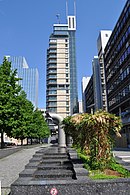
|
Well system in front of the residential high-rise Stephanstraße 18 | Frankfurt city center | Stephanstrasse 18 50 ° 7 ′ 0 ″ N, 8 ° 40 ′ 55 ″ E |
There is an elongated fountain in front of the residential tower at Stephanstraße 18 |

|
Well of virtue | Frankfurt city center |
Töngesgasse in front of No. 13 50 ° 6 ′ 48 ″ N, 8 ° 41 ′ 3 ″ E Monument protection |
Classicist pump fountain (copy) with allegorical rococo statues . The rococo statue dates from 1768, the pump well from 1832. The well was previously a draw well and was named Heilig-Geist-Brunnen. |

|
Venetians fountain | Frankfurt city center | Behind the Katharinenkirche at the Hauptwache 50 ° 6 ′ 47 ″ N, 8 ° 40 ′ 47 ″ E Monument protection |
The Venetian Fountain is an ornamental fountain in the neo-Renaissance style from around 1870. The water basin with the four lion heads has a diameter of 0.80 meters. The 1.20 meter high Jura marble fountain originally stood in a garden on Pfingstweidstrasse. After the renovation by Hugo and Rainer Uhl, it was installed behind the Katharinenkirche in 1981. |

|
Vintner's fountain | Frankfurt city center | Taunusanlage 50 ° 6 ′ 48 ″ N, 8 ° 40 ′ 10 ″ E Monument protection |
The Winzer or Lachhannes fountain is a sandstone column, crowned by a bronze bust by the sculptor Johann Nepomuk Zwerger . It was inaugurated on July 1, 1859. The fountain was removed before the Second World War and placed again in the Taunusanlage in 1947. |

|
Boniface fountain | Frankfurt-Kalbach-Riedberg | Bonifatiuspark 50 ° 10 ′ 33 ″ N, 8 ° 38 ′ 28 ″ E |
According to legend, the Boniface Spring was built where the corpse of St. Boniface rested. The Bonifatiusbrunnen was a small fountain which was surmounted by a wooden cross made by Hugo Uhr from Frankfurt . In 2006 the Bonifatiuspark was created and the Bonifatiusbrunnen was redesigned by the architects Bernard, Müggenburg and Sattler . The spring rises today in a deep well chamber, around which the seat walls are made of light granite. |

|
Foul well | Frankfurt-Nied | Well path 50 ° 6 ′ 31 ″ N, 8 ° 35 ′ 5 ″ E |
The Faulbrunnen (also Grintbrunnen) is an old spring with sulphurous water. The fountain was set in stone in 1828. The roof was built in 1914 at the instigation of the Nied beautification and traffic association. The fountain was redesigned in 1936 based on a design by Nieder architect Johannes Schmidt. The fountain stone with the shell comes from the Unterliederbach sculptor Franz Schranz . |

|
Selzerbrunnen | Frankfurt-Nied | At the end of the street Am Selzerbrunnen in the forest 50 ° 6 ′ 38 ″ N, 8 ° 35 ′ 6 ″ E |
The “Selzerbrunnen”, drilled in 1927, is a sulphurous mineral well. The fountain consists of a sandstone cube by the sculptor Franz Schranz from 1939. |

|
Town hall fountain in Nied | Frankfurt-Nied | Alt-Nied 50 ° 6 ′ 0 ″ N, 8 ° 33 ′ 52 ″ E |
In 1985 an iron pump well was set up in front of the old town hall in Nied, which is based on an old handle pump. But this is not the original; the pump acquired by the municipal forestry office was converted by the then Hoechst AG and installed at its current location, a sign refers to the activities of the Nied citizens' association. |
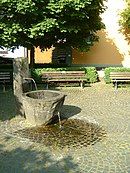
|
Bürgerbrunnen Niedererlenbach | Frankfurt-Niedererlenbach | Place “Am Bürgerbrunnen” 50 ° 12 ′ 10 ″ N, 8 ° 42 ′ 33 ″ E |
The Nieder-Erlenbach Bürgerbrunnen is a former baptismal font and was set up in its current location in 1994 |

|
Waldsprudel on the Pfingstberg | Frankfurt-Niedereschbach | In a wood to the left of the Eschbach between Nieder-Eschbach and Harheim 50 ° 11 ′ 47 ″ N, 8 ° 40 ′ 50 ″ E |
Contained basin of a former artesian spring . It is said to have had a bubbling fountain at the beginning of the 20th century. |

|
Pond Ben Gurion Ring | Frankfurt-Niedereschbach | Ben Gurion Ring 50 ° 11 ′ 23 ″ N, 8 ° 39 ′ 44 ″ E |
The Ben-Gurion-Ring surrounds a park area with a pond with a fountain on the northern edge. |

|
Fountain on the Bürgerwiese | Frankfurt-Niederrad | in the forest triangle of Kennedyallee, Niederräder Landstrasse and Mörfelder Landstrasse on the east side of the meadow 50 ° 5 ′ 9 ″ N, 8 ° 39 ′ 41 ″ E |
The fountain consists of a tower made of two unequally large cuboids and a sandstone basin. In front of it is a large, semicircular brick well basin made of sandstone. |

|
Lower fountain | Frankfurt-Niederrad | Schwanheimer Strasse 107 50 ° 5 ′ 16 ″ N, 8 ° 38 ′ 14 ″ E is a listed building |
The Nieder Brunnen (which is not in Nied, but in Niederrad) was created in 1911 by the Niederbrunnengesellschaft and the Niederräder District Association. The red sandstone fountain was restored after the war and repaired on the occasion of the parish fair on June 7, 1953. At the end of 1969 the well was demolished to make way for new buildings. After protests by the residents, the well was then rebuilt at its current location on the edge of the settlement. |
| Struwwelpeterbrunnen (stadium pool) | Frankfurt-Niederrad | Mörfelder Landstrasse, Stadionbad 50 ° 4 ′ 17 ″ N, 8 ° 39 ′ 4 ″ E |
In 1910, the Schwanheim sculptor Johann Joseph Belz received the order for the fountain from the “Comité for the erection of a memorial fountain for Dr. Heinrich Hoffmann ”. The work was completed in 1923 and unveiled on July 6, 1929. The sandstone fountain stick is crowned by the bronze sculpture of Struwwelpeter on a rocking horse in a wheel. The fountain basin is a round stone bowl with nine children, two tablets and a portrait relief of Dr. Heinrich Hoffmann made of bronze. | |

|
Upper wheels gardener pump | Frankfurt-Oberrad | Southeast corner of Buchrainplatz 50 ° 6 ′ 1 ″ N, 8 ° 43 ′ 28 ″ E Monument protection |
Cast iron pump, originally between allotments on Hansenweg. Since 1976 on Buchrainplatz |
| Labor Court and Social Court Well | Frankfurt-Nordend |
Adickesallee 36 50 ° 7 ′ 57 "N, 8 ° 40 ′ 43" E |
The square building of the labor court encloses an inner courtyard. In 1962 a fountain created by the artist Erich Kuhn was installed in the inner courtyard . | |

|
Günthersburgpark | Frankfurt-Nordend | Günthersburgpark 50 ° 7 ′ 45 ″ N, 8 ° 42 ′ 13 ″ E |
"Sprühfeld" water playground |

|
Merianplatz fountain | Frankfurt-Nordend | Merianplatz 50 ° 7 ′ 14 ″ N, 8 ° 41 ′ 45 ″ E |
In April 1981 the fountain by the artist Hans Steinbrenner was inaugurated. The cylindrical fountain sculpture camouflages the subway's ventilation shaft |
| Nibelungenplatz fountain | Frankfurt-Nordend | Nibelungenplatz 50 ° 7 ′ 44 ″ N, 8 ° 41 ′ 32 ″ E |
The fountain system made of granite blocks was designed by Ludwig Fischer in 1980 | |

|
Fountain on Alfred-Brehm-Platz | Frankfurt-Ostend | Alfred-Brehm-Platz 50 ° 6 ′ 57 ″ N, 8 ° 41 ′ 54 ″ E |
Fountain in the center of Alfred-Brehm-Platz in front of the Frankfurt am Main Zoo |

|
Frankfurt East Harbor | Frankfurt-Ostend | Osthafenplatz 50 ° 6 ′ 38 ″ N, 8 ° 42 ′ 45 ″ E is a listed building |
In 1912 the Osthafen fountain was built in the center of Osthafenplatz, presumably by the Frankfurt sculptor Johann Joseph Belz , in the traditional form of a "horse trough". There are cattle troughs on both sides of the symmetrical well. The fountain lost its function with increasing motorization and is now drained. The fountain is decorated with neoclassical mascaron and nereid reliefs |

|
Ostpark Frankfurt am Main | Frankfurt-Ostend | Ostpark 50 ° 7 ′ 7 ″ N, 8 ° 43 ′ 16 ″ E is a listed building |
Neoclassical drinking fountain from 1927 |
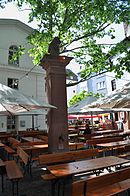
|
Monkey fountain | Frankfurt-Sachsenhausen |
Affentorplatz 50 ° 6 ′ 17 ″ N, 8 ° 41 ′ 25 ″ E Monument protection |
The Frankfurt sculptor Georg Krämer created today's monkey fountain behind one of the guard houses on Affentorplatz in 1958. A previous fountain with a fountain basin in the shape of a monkey from 1938 was destroyed in the air raids on Frankfurt am Main during World War II. The current fountain is crowned by the figure of a baboon. |

|
Artichoke fountain | Frankfurt-Sachsenhausen | Klappergasse 50 ° 6 ′ 19 ″ N, 8 ° 41 ′ 27 ″ E Monument protection |
The rattle or artichoke fountain created by the stonemason Georg Wilhelm Mayr was moved from Klappergasse in front of the Willemer / Frankenstein School in 1959 and moved back to its old location in 2007. The pillar is adorned with wreaths and garlands. On the plate is an urn with the eponymous artichoke knob. |

|
Baker's fountain | Frankfurt-Sachsenhausen | Formerly in the inner courtyard of the "House of Youth" in the Große Rittergasse near the Kuhhirtenturm. 50 ° 6 ′ 24 ″ N, 8 ° 41 ′ 22 ″ E is a listed building |
In 1794 the medieval draw well on Elisabethenstrasse was converted into a classicist pump well. After the entire Elisabethenstrasse was destroyed in the war in 1943, the location was relocated. The Frankfurt sculptor Georg Krämer restored the fountain, which was opened on August 20, 1960. One is a simple pillar made of red sandstone with attached cuboids, a cornice and a vase. |

|
Bockenheimerdenkmal fountain | Frankfurt-Sachsenhausen | Oppenheimer Platz 50 ° 6 ′ 15 ″ N, 8 ° 40 ′ 59 ″ E is a listed building |
On the Oppenheimer Place 1932 is October 16, "Bockenheimer Memorial Fountain" of the Frankfurt sculptor August Bischoff , of the Dr. Jakob Hermann Bockenheimer (1837–1908) remembered. It is a fountain made of shell limestone on a 1.50 meter high cement base with a relief head, on which stands a life-size, naked youth sculpture with raised arms. The bronze sculpture was melted down in 1942 and re-cast from copper in 1949. The sculpture fell victim to vandalism in the 1960s when strangers shot holes in its legs. The damage was repaired by the sculptor Kurt Zobel . |
| Boehlehaus fountain | Frankfurt-Sachsenhausen | First waiting alley 50 ° 5 ′ 10 ″ N, 8 ° 41 ′ 26 ″ E is a listed building |
The “Boehlehaus fountain”, created by the Frankfurt sculptor Fritz Boehle, has stood by a small pond in the garden of the Boehlschen estate in 1. Waiting Alley. Boehle moved into the house in 1910, set up a studio and turned the villa into an artists' home. The fountain is a draw well, designed according to the forms of the German Renaissance. Two Corinthian columns tower up on the ring parapet, with a lintel, which is closed off by two reclining horse sculptures. | |

|
Carolus fountain | Frankfurt-Sachsenhausen | At the acute angle of Darmstädter Landstrasse and Kranichsteiner Strasse 50 ° 6 ′ 1 ″ N, 8 ° 41 ′ 28 ″ E |
Fritz Boehle made a draft of a Karlsreider for the Old Bridge in 1910. The magistrate decided on an order in 1911, but it did not come to fruition. In 1967 the Binding Brewery financed a casting of the statue and donated it to the city in 1973. The new Carolus Fountain was created at the current location and the statue was placed there |
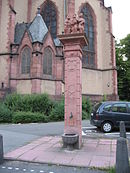
|
Dreikönigsbrunnen | Frankfurt-Sachsenhausen | Behind the Dreikönigskirche 50 ° 6 ′ 25 ″ N, 8 ° 41 ′ 7 ″ E Monument protection |
The Dreikönigsbrunnen from 1781 was redesigned from the pump column of a medieval draw well from the 14th century for around 400 guilders into a classicist pump well. In 1887, after the Second World War, the fountain was renewed. The statue of the Magi stands on the square pillar with a frieze. |
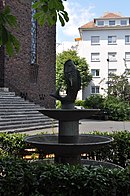
|
Fish fountain | Frankfurt-Sachsenhausen | Holbeinstrasse in front of the Bonifatiuskirche 50 ° 5 ′ 53 ″ N, 8 ° 40 ′ 41 ″ E |
The fish fountain is in front of the Bonifatiuskirche. Three metal fountain bowls, one above the other, tapering towards the top, are crowned by a fish that spits water. |

|
Butcher's fountain | Frankfurt old town | Five-finger cookies 50 ° 6 ′ 22 ″ N, 8 ° 41 ′ 30 ″ E Monument protection |
The butcher's or raftsman's fountain is a classicist pump well from around 1800. It takes its name from the neighboring house "Zum Fleischer" at the time. The fountain on the five-finger cookie was largely destroyed by bombs during World War II. In 1968 it was reconstructed by the Frankfurt sculptor Georg Krämer based on old views and fragments. |

|
Frau Rauscher Fountain | Frankfurt-Sachsenhausen | Between the houses at Klappergasse 8 and 12, diagonally opposite the Steinern house, 50 ° 6 ′ 19 ″ N, 8 ° 41 ′ 29 ″ E is a listed building |
The fountain designed by Georg Krämer from 1961 is reminiscent of Mrs. Rauscher, who became famous in the carnival song. |

|
Gardener's fountain | Frankfurt-Sachsenhausen | Courtyard of the Mühlbergschule at Lettigkautweg 8 50 ° 5 ′ 55 ″ N, 8 ° 42 ′ 8 ″ E Monument protection |
The gardener's fountain is a late Classicist pump fountain from the second half of the 19th century made of sandstone with two symmetrically arranged basins. The fountain figure represents a gardener. |
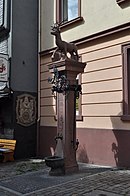
|
Deer fountain | Frankfurt-Sachsenhausen | Before Große Rittergasse 30, 50 ° 6 ′ 21 ″ N, 8 ° 41 ′ 31 ″ E is a listed building |
Already on Merian's plan from 1628 a medieval draw well, the zoo fountain, is shown. The current fountain dates back to 1796 when it was converted from a drawing fountain to a pump fountain. The sump rod, forged in the traditional Rococo style, was created in 1890 by an unknown blacksmith. In 1962 Georg Krämer renovated the deer fountain. The stag on the cover plate refers to the zoo that used to be located there and / or to the legendary hind, which showed Charlemagne fleeing the Saxons the safe path through the Main ford. |

|
Chicken or cube well | Frankfurt-Sachsenhausen | Johanna-Melberg-Weg / Hühnerweg 50 ° 6 ′ 0 ″ N, 8 ° 41 ′ 48 ″ E |
The chicken or cube fountain was created in 1967 by the garden architect Herbert Heise from Michelnau basalt lavatuff stone cubes . The client was the non-profit association for dormitories and workers' apartments in Frankfurt am Main |

|
St. George Well | Frankfurt-Sachsenhausen | Corner of Große Rittergasse and Frankensteiner Straße 50 ° 6 ′ 22 ″ N, 8 ° 41 ′ 27 ″ E |
In the 15th century, a knight born was mentioned at the site, which was replaced by the knight's fountain in 1788. According to old photos, the stonemason Rainer Knußmann created the historical knight's fountain with the figure of a knight, St. Georgs stabbing a dragon to be recreated. |

|
Klapergass fountain | Frankfurt-Sachsenhausen | Klappergaß 50 ° 6 ′ 20 ″ N, 8 ° 41 ′ 26 ″ E Monument protection |
The former Hintergaßbrunnen, created in 1798, was set up after renovation in 1966 under the name Klappergaßbrunnen on the north side of Klappergasse. |
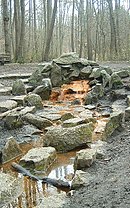
|
Königsbrünnchen | Frankfurt-Sachsenhausen | Stadtwald, Oberschweinstiege 50 ° 4 ′ 30 ″ N, 8 ° 40 ′ 42 ″ E |
The Königsbrünnchen was first mentioned in a document as the Konigsborn. It is a contained spring whose name goes back to the legend of Emperor Ludwig III. back who stopped at this source and is said to have had a vision there. The spring carries water which is said to have a healing effect. |

|
Fountain at the Liebieghaus | Frankfurt-Sachsenhausen | Back of the Liebieghaus (Steinlestrasse) 50 ° 6 ′ 6 ″ N, 8 ° 40 ′ 20 ″ E |
There is a fountain on the back wall of the Liebieghaus. A larger than life lion spews water into an oval fountain bowl. |

|
Museum of World Cultures | Frankfurt-Sachsenhausen | To the left of the Museum für Weltkulturen 50 ° 6 ′ 20 ″ N, 8 ° 40 ′ 48 ″ E |
|

|
Museum of World Cultures | Frankfurt-Sachsenhausen | Between Schaumainkai 29 and Metzlerstrasse 50 ° 6 ′ 19 ″ N, 8 ° 40 ′ 46 ″ E |
Shell-shaped horse trough |

|
Mühlberg fountain I | Frankfurt-Sachsenhausen | Offenbacher Landstrasse 50 ° 6 ′ 5 ″ N, 8 ° 41 ′ 37 ″ E is a listed building |
During the construction of the walls on Mühlberg, two large well basins were built into the wall. |
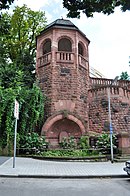
|
Mühlberg Fountain II | Frankfurt-Sachsenhausen | Offenbacher Landstrasse 50 ° 6 ′ 6 ″ N, 8 ° 41 ′ 42 ″ E is a listed building |
During the construction of the walls on Mühlberg, two large well basins were built into the wall. |

|
Fountain of Paradise | Frankfurt-Sachsenhausen | Paradiesplatz 50 ° 6 ′ 21 ″ N, 8 ° 41 ′ 23 ″ E Monument protection |
The listed Paradiesbrunnen from 1786 with the figures of Adam and Eve with an apple tree as a crown was renovated in 1956 and moved from its previous location at the confluence of Paradiesgasse into Große Rittergasse to its current location. |

|
Quirius fountain (formerly also "begging fountain") | Frankfurt-Sachsenhausen | Offenbacher Landstrasse opposite house number 13 50 ° 6 ′ 3 ″ N, 8 ° 41 ′ 33 ″ E is a listed building |
Fountain from 1790 on the former city wall, the Quirin Gate |

|
Riedhof fountain | Frankfurt-Sachsenhausen | Next to Mörfelder Landstrasse 212, 50 ° 5 ′ 29 ″ N, 8 ° 40 ′ 23 ″ E is a listed building |
The "Riedhof fountain" from 1815, a classical fountain stick with a long trough in front of it, served as a cattle trough. It was destroyed in World War II and redesigned in August 1974 for the 484th Fountain Festival in Sachsenhausen |
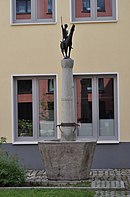
|
Knight's Fountain | Frankfurt-Sachsenhausen | former Frankensteiner Hof 50 ° 6 ′ 23 ″ N, 8 ° 41 ′ 21 ″ E |
In 1964, the knight's fountain created by Georg Krämer was set up in the back alley at the "Schwarzer Ritter" wine tavern and in 2008 it was moved to its current location. The fountain consists of a round column with four metal spouts that spew water into an octagonal basin. The pillar is crowned by a metal knight with a lance on a horse. |

|
Rotkäppchenbrunnen | Frankfurt-Sachsenhausen | Opposite the Lukaskirche on Otto-Hahn-Platz 50 ° 6 ′ 5 ″ N, 8 ° 40 ′ 28 ″ E |
The Little Red Riding Hood fountain was created in 1912 from artificial stone by the Frankfurt sculptor Johann Joseph Belz . In April 1912 it was originally set up opposite the Schillerschule and in 1964 moved about 100 meters to the south-west to where it is today. The fountain has two sculptural figures on a base and is symmetrical. |

|
Fountain in the Sachsenhausen control center | Frankfurt-Sachsenhausen | in the inner courtyard of the Sachsenhausen waiting room 50 ° 5 ′ 18 ″ N, 8 ° 41 ′ 29 ″ E |
There is a draw well in the inner courtyard of the Sachsenhausen observation point |

|
Fountain at the Südbahnhof | Frankfurt-Sachsenhausen | Diesterwegplatz 50 ° 5 ′ 59 ″ N, 8 ° 41 ′ 8 ″ E |
There is a small fountain to the right of the Südbahnhof building. Water flows from a wall over an inclined plane into the fountain basin. The basin is currently planted, the well is dry |

|
Main Plaza | Frankfurt-Sachsenhausen | Walter von Cronberg Platz 50 ° 6 ′ 22 ″ N, 8 ° 41 ′ 49 ″ E |
There is a large fountain on Walter von Cronberg-Platz |

|
Water spray systems on the forest playgrounds | Frankfurt-Sachsenhausen | Frankfurt city forest | There are 7 forest playgrounds in the Frankfurt city forest, some of which are equipped with paddling pools and water spray systems. The spray fountains are partially equipped with fantasy figures by the sculptor Hugo Uhl . The picture shows the Scheerwald playground. Spray fountains can be found (in the order in which they arise) in the Schwanheim forest play park, in the Höchst city park, in the Eschersheim outdoor pool and in the Tannenwald forest recreation park. Not all systems have survived. |

|
Guild fountain | Frankfurt-Sachsenhausen |
Affentorplatz 50 ° 6 ′ 16 ″ N, 8 ° 41 ′ 23 ″ E |
The guild fountain by the Frankfurt sculptor Anneliese Sund-Kern was inaugurated in August 1971 for the 481st Fountain Festival. On a high plinth made of shell limestone, there is an 85 centimeter high group constellation made of bronze with eight figures of craftsmen. |

|
Foul well | Frankfurt-Sossenheim | opposite the house “Am Faulbrunnen 5” on Sulzbach 50 ° 7 ′ 7 ″ N, 8 ° 33 ′ 58 ″ E |
The Faulbrunnen or Schermulybrunnen was built from shell limestone in 1926. The source of the foul well is located at a depth of 60 meters and promotes sulphurous water with a foul odor, which is considered to be medicinal. The fountain is part of the mineral spring area that extends from the Kronthal spring park to the springs of Bad Soden am Taunus to Sossenheim. |
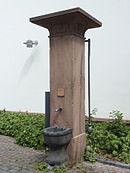
|
Schwanheimer pump well | Frankfurt-Schwanheim | Local history museum 50 ° 5 ′ 12 ″ N, 8 ° 34 ′ 52 ″ E Monument protection |
Originally placed between the old school and the church in the alley "am Abtshof", it is now in the courtyard of the local history museum (old school) |

|
Duck well | Frankfurt-Sindlingen | Richard Weidlich Platz 50 ° 5 ′ 16 ″ N, 8 ° 30 ′ 41 ″ E |
The fountain was designed by the Supreme City Councilor and inking director Dr. Richard Weidlich donated in 1924. The four ducks (a fourth duck was stolen but replaced) by the sculptor August Gaul (1869–1921) are artistically valuable . Gaul had already created a comparable duck fountain in Berlin-Charlottenburg in 1911 |

|
Sindlinger pump well | Frankfurt-Sindlingen | In front of the Catholic Church 50 ° 4 ′ 49 ″ N, 8 ° 31 ′ 7 ″ E is a listed building |
The only remaining well from the time before the construction of the water network, probably built at the same time as the church. Pump well made of red Main sandstone. Refurbished in 1980. |
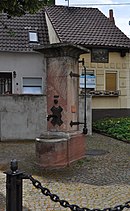
|
Ranzenplatz fountain | Frankfurt-Sindlingen | Angle of Huthmacherstraße and Ranzengasse 50 ° 4 ′ 49 ″ N, 8 ° 31 ′ 7 ″ E Monument protection |
This fountain was dismantled in Sindlingen before the First World War and erected in Höchst. In 1878 it was rebuilt at its current location |

|
Roman fountain | Frankfurt-Schwanheim | Roman stone fountain from the 2nd / 3rd century Century. The fountain was discovered in 1973. | |
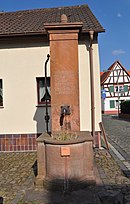
|
Zehntgassenbrunnen | Frankfurt-Schwanheim | Zehntgasse 50 ° 5 ′ 12 ″ N, 8 ° 34 ′ 57 ″ E |
The Zehntgassenbrunnen is a classicistic pump well from 1828 |
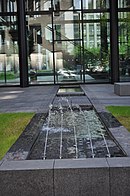
|
Fountain next to the BHF-Bank high-rise | Frankfurt-Westend | Oberlindau 2 50 ° 7 ′ 0 ″ N, 8 ° 40 ′ 6 ″ E |
There is a small fountain next to the BHF high-rise building on the Oberlindau. |

|
Skyscraper at the park | Frankfurt-Westend | Behind the skyscraper at Park 50 ° 7 ′ 23 ″ N, 8 ° 39 ′ 59 ″ E |
Behind the skyscraper at the park is a large rectangular fountain basin with a fountain |

|
Fountain on the Westend campus , "Nymph on the water" | Frankfurt-Westend | Campus Westend between the casino and the main building 50 ° 7 ′ 34 ″ N, 8 ° 40 ′ 2 ″ E |
The central design element between the IG Farben building and the casino building is a park with terraces and tiered water basins with the nymph sculpture created by Fritz Klimsch on the water. |

|
Ball fountain | Frankfurt-Westend |
Palmengarten Frankfurt 50 ° 7 ′ 17 ″ N, 8 ° 39 ′ 28 ″ E |
The ball fountain was created in 1989 by the sculptor Christian Tobin . On a 0.57 × 1.40 × 2.40 m base or source stone there is a 1.8 ton granite ball that can be moved by hand on a thin layer of water. |
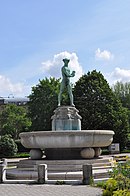
|
Mercury fountain | Frankfurt-Westend | In front of the main entrance to the fair at the Messekreisel 50 ° 6 ′ 49 ″ N, 8 ° 39 ′ 4 ″ E Monument protection |
The listed Merkur fountain is a neoclassical fountain from 1916. It was designed by Hugo Lederer as a foundation of the banker ALA Hahn. Mercury as the god of trade and traders points to the exhibition grounds behind the fountain. |

|
Fountain in the palm garden | Frankfurt-Westend |
Palmengarten Frankfurt 50 ° 7 ′ 25 ″ N, 8 ° 39 ′ 23 ″ E |
There is a large fountain in the palm garden. |

|
Dandelion fountain | Frankfurt-Westend |
Campus Westend 50 ° 7 ′ 40 ″ N, 8 ° 39 ′ 58 ″ E |
The Bockenheimer Dandelion Fountain was created in 1982 only by university employees at the suggestion of former university president Kelm. For 2008 it was decided to move from the current Bockenheim campus to the Westend campus . In 2011 it was dismantled after technical problems, but is to be rebuilt. (The picture shows the fountain at the old location) |
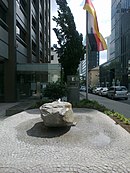
|
Fountain in front of the SEB AG building | Frankfurt-Westend | Ulmenstrasse 30 50 ° 6 ′ 58 ″ N, 8 ° 39 ′ 57 ″ E |
There is a small fountain in front of the Ulmenstrasse 30 building used by SEB AG . |

|
Fountain in front of the Villa Leonhardi | Frankfurt-Westend |
Villa Leonhardi 50 ° 7 ′ 25 ″ N, 8 ° 39 ′ 12 ″ E |
There is a small fountain in front of Villa Leonhardi on Zeppelinallee. |
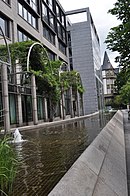
|
West Arcade Fountain | Frankfurt-Westend | In front of the West Arcade on Bockenheimer Landstrasse 50 ° 7 ′ 12 ″ N, 8 ° 39 ′ 21 ″ E |
In front of the Westarkade building used by KfW , there is an elongated pool with a series of small fountains. |
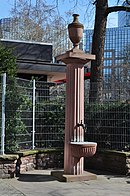
|
Westendbrunnen | Frankfurt-Westend | On the square in front of the former country house on Bockenheimer Landstrasse 50 ° 6 ′ 56 ″ N, 8 ° 40 ′ 9 ″ E Monument protection |
Listed classicist pump well on the former Malapert property. The fountain consists of a tall Doric column with a console on which a simple vase stands. After the Malapert house was demolished, the fountain was preserved in 1958. In 1978 it was replaced by a sandstone copy. |
| Fountain at the Westend Synagogue | Frankfurt-Westend | Freiherr vom Stein-Straße 30 50 ° 7 ′ 16 ″ N, 8 ° 39 ′ 51 ″ E |
In front of the synagogue, which opened in 1910, is the round fountain by the sculptor Franz Roeckle | |

|
Frog fountain (Zeilsheim) | Frankfurt-Zeilsheim | Welschgrabenstrasse 50 ° 5 ′ 42 ″ N, 8 ° 29 ′ 27 ″ E |
In 1984 the frog fountain was inaugurated. In 1992, however, the eponymous frog was stolen so that a new frog was commissioned with donations from the citizens. The red sandstone frog measures 60 by 45 cm and sits on a 50 cm high base. He only spits drinking water into the round mussel basin during the fountain festival. |
More wells
- Fountain in the Martin-Henrich-Anlage
- Frog Prince Fountain
- Stillsborn
- Tiergarten fountain
Former fountain
| image | Surname | District | location | annotation |
|---|---|---|---|---|

|
Aland fountain | Frankfurt old town | former Einhorngässchen (Pfarrgäschen, which ran parallel to the Fahrgasse) south of the Dominican monastery 50 ° 6 ′ 41 ″ N, 8 ° 41 ′ 14 ″ E |
The “Rote Badstube”, a leading bathhouse in Frankfurt, had a fountain that both supplied the bathhouse with water and allowed water to be fetched from outside. This Rodinborn changed the name to Olenborn, Olensbrfunnen, Alensbrunnen and finally Alandsbrunnen over the centuries. By 1628 at the latest, the fountain had been moved away from the house to the square and designed as a draw well. In 1770 it was converted into a pump well. A girl stood on the sandstone pillar with a basket of Olands pears. In 1944 it was destroyed in the war |
| Fischerbrunnen or Neptunebrunnen | Frankfurt old town | former Fischergasse 50 ° 6 ′ 35 ″ N, 8 ° 41 ′ 11 ″ E |
In a small square on Fischergasse, the Fischerbrunnen was first named in a document in 1448. In 1782 the draw well for 600 guilders was replaced by a classicist pump well designed by the stonemason Thomas Scheidel . On the fountain column was a statue of Neptune, from which the fountain got its name. The fountain was last renovated in 1889 and destroyed in the Second World War. | |

|
Carthusian fountain | Frankfurt old town | Former Carthusian farm between Predigergasse, Dominikanergasse and Fahrgasse 50 ° 6 ′ 41 ″ N, 8 ° 41 ′ 14 ″ E |
A renaissance draw well made of red Main sandstone, with an unusual bell-shaped roof. The fountain was destroyed in World War II. |
| Knäbleinsbrunnen | Frankfurt old town | Near the former Frauenpforte 50 ° 6 ′ 35 ″ N, 8 ° 40 ′ 48 ″ E |
The Knäbleinsbrunnen (Knäbleinsbrunnen), first mentioned in a document in 1398, stood near the city wall, which was converted into a pump well in 1792 and demolished at the end of the 19th century. | |
| Königsbrunnen | Frankfurt old town |
|
The Königsbrunnen was a fountain on Allerheiligenstraße and was demolished in 1888. The crowning statue (possibly Franz I) by Dazerath was placed on the scoop fountain. | |

|
Lammchenbrunnen | Frankfurt old town |
Behind the lamb between market and chicken market 50 ° 6 ′ 39 ″ N, 8 ° 41 ′ 1 ″ E |
The fountain, first mentioned in a document in 1478, was named after the exhibition center Goldenes Lammchen . In 1755 it was converted into a pump well. There was a gold-plated lamb on the sandstone pillar. Around 1800 it was placed on the wall of the house "Zum alten Burggraf" as a decorative element and destroyed in the Second World War. |

|
Leonhardsbrunnen | Frankfurt old town | Today's Buchgasse 50 ° 6 ′ 32 ″ N, 8 ° 40 ′ 47 ″ E |
At the latest in the 14th century, the Leonhardstor was created opposite the churchyard. It is shown as a draw well on Merian's plan from 1624. At the end of the 18th century it became a classicist pump well. The Leonhardstor and the fountain were demolished around 1818. The picture is a section of a colored drawing by Friedrich Wilhelm Delkeskamp before 1835. |
| Red Cross Fountain | Frankfurt old town | Rotkreuzgasse 50 ° 6 ′ 42 ″ N, 8 ° 40 ′ 42 ″ E |
The Dietrichsborn, which was first mentioned in a document in 1411, was located on the former Dietrichsgasse. When the street was renamed Rotkreuzgasse, the fountain became the Rotkreuzbrunnen in 1596. In 1760 the drawing well was supplemented by a pump and replaced in 1807 by a classicist pump well by Bernhard Scheidel for 650 guilders . It was crowned by a stylized cairn with a cross. Last renovated in 1887, it lost its function in 1920 and was destroyed in the Second World War. | |
| Eselborn | Frankfurt-Bergen-Enkheim | Bergen 50 ° 10 ′ 19 ″ N, 8 ° 46 ′ 18 ″ E |
Eselsborn was first mentioned in 1340, making it one of the oldest known wells in the town. With the construction of the water pipes in Bergen in 1897, it lost its function. It no longer exists today | |
| Hessenborn | Frankfurt-Bergen-Enkheim | Bergen 50 ° 9 ′ 9 ″ N, 8 ° 45 ′ 0 ″ E |
The Hessenborn below the Heinrich Bingemer Weg was described in 1827 as a stone fountain with wooden pipes. It no longer exists today. | |

|
War memorial | Frankfurt-Bergen-Enkheim | Landgraben / Marktstrasse intersection 50 ° 9 ′ 18 ″ N, 8 ° 44 ′ 59 ″ E |
The Jacob's fountain was originally a wooden column with iron pipes on both sides and wooden troughs. In 1930 it was dismantled and the monument to the fallen was erected in its place. The monument to the fallen was inaugurated on March 1, 1930 and is modeled on the fountain |
| Pentecost Born | Frankfurt-Bergen-Enkheim | Fritz Schubert Ring 46a 50 ° 9 ′ 18 ″ N, 8 ° 45 ′ 34 ″ O |
The Pfingstborn was a fountain that was built at the beginning of the 18th century. The source room was made of limestone and was 1.80 meters high, 3.30 meters wide and 1.80 meters long. It no longer exists. | |
| Pfortenborn | Frankfurt-Bergen-Enkheim | Bergen 50 ° 9 ′ 19 ″ N, 8 ° 45 ′ 13 ″ E |
The Pfortenborn at the former lower gate was a very productive well, which in 1827 comprised one stone and three wooden troughs and two iron pipes. It no longer exists today, but a replica was built. | |
| Schalksborn | Frankfurt-Bergen-Enkheim | Bergen 50 ° 10 ′ 1 ″ N, 8 ° 45 ′ 3 ″ E |
Like the Eselsborn, the Schalksborn is one of the oldest known fountains in the town. With the construction of the water pipes in Bergen in 1897, it lost its function. It no longer exists today. | |
| Schnappborn | Frankfurt-Bergen-Enkheim | Bergen 50 ° 9 ′ 27 ″ N, 8 ° 45 ′ 7 ″ E |
The Schnappborn in the former Schnappborngasse (today: Schelmenweg) was described in 1827 as a fountain made of bricks with a wooden fountain column. It no longer exists today. | |
| Steinborn | Frankfurt-Bergen-Enkheim | Marktstrasse 50 ° 9 ′ 18 ″ N, 8 ° 45 ′ 10 ″ E |
The Steinborn was created in 1343. It was a draw well that was destroyed before the First World War. | |
| Kondelsborn | Frankfurt-Bockenheim |
|
The Kondelsborn was a draw well that was converted into a classicist pump well in 1777. At the end of the 19th century it was dismantled after the water supply network was built. | |
| Rapid well | Frankfurt-Bockenheim | Schlossstrasse 16 50 ° 7 ′ 23 ″ N, 8 ° 38 ′ 13 ″ E |
The Schnellbrunnen was a draw well that was converted into a classicist pump well in 1778. At the end of the 19th century it was dismantled after the water supply network was built. | |
| Stockborn | Frankfurt-Bockenheim | Fritzlarer Strasse 8 50 ° 7 ′ 33 ″ N, 8 ° 38 ′ 10 ″ E |
The Stockborn was a draw well that was converted into a classicist pump well in 1764. At the end of the 19th century it was dismantled after the water supply network was built. | |
| New Arnsburg fountain | Frankfurt-Bornheim | Berger Strasse 50 ° 7 ′ 32 ″ N, 8 ° 42 ′ 25 ″ E |
In 1980, the New Arnsburger Brunnen was erected opposite the clock tower for 90,000 DM. The Munich sculptors Andreas Sobeck and Manfred Mayerle had created a “wolf tang that bursts out of the ground”. The vernacular spoke of the "tin box", "wet coffin" or "garbage can". A citizens' initiative against the well was formed and the well was removed at the request of the local council. In 1983 the Reichsdorf-Bornheim-Brunnen was built in its place (see there) | |
| Pelican fountain | Frankfurt-Frankfurter Berg | Albert Schweitzer School, Berkersheimer Weg 26 50 ° 10 ′ 2 ″ N, 8 ° 40 ′ 32 ″ E |
The pelican fountain was a drinking fountain at the Albert Schweitzer School that was designed by the Frankfurt sculptor Cläre Bechtel . In 1950 Schweitzer wrote a book A pelican tells about his life . At the school there is the "pelican house" | |
| Frog fountain (airport) | Frankfurt Airport |
Airport |
In 1952, the Frankfurt sculptor Georg Krämer created the frog fountain on what was then the children's playground. The fountain was dismantled with the renovation and expansion of the airport. | |

|
Northwest Center Fountain | Frankfurt-Heddernheim | NWZ in front of the community center 50 ° 9 ′ 29 ″ N, 8 ° 37 ′ 57 ″ E |
The fountain in front of the community center in the NWZ was created in 1968 by Hermann Goepfert . It consisted of the Klima stele in the middle of fountains of varying heights. As part of the renovation of the NWZ, the well was dismantled and the climate stele was stored in 1987. |
| Arable well | Frankfurt city center | in front of today's Eldorado cinema 50 ° 7 ′ 1 ″ N, 8 ° 41 ′ 7 ″ E |
The Ackerbrunnen was first mentioned in a document as Ackermannsborn in 1460. In 1636 it was first mentioned as a field well. Around 1830 it was a classical sandstone column with mallets in front of the old St. Peter's Church. Removed around 1860. | |
| Eagle fountain | Frankfurt city center | Heumarkt (today Hauptwache, exit Schillerstraße) 50 ° 6 ′ 51 ″ N, 8 ° 40 ′ 42 ″ E |
With the construction of the Hauptwache in 1730, a pump well was built east of it on the edge of the Paradeplatz and the beginning of the Zeil. This consisted of a fluted stone pillar, crowned by an eagle. In 1859 the fountain was moved. He went under in World War II. | |
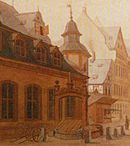
|
Constable Wake Fountain | Frankfurt city center | Konstablerwache 50 ° 6 ′ 53 ″ N, 8 ° 41 ′ 15 ″ E |
There has been a draw well in front of the Konstablerwache since the Middle Ages. In 1822 the fountain was demolished to make way for the road to be widened. |
| Schützenbrunnen | Frankfurt city center | in front of the zoo on today's Alfred-Brehm-Platz 50 ° 6 ′ 57 ″ N, 8 ° 41 ′ 54 ″ E |
The Schützenbrunnen in front of the zoo was inaugurated on August 24, 1894 in memory of the federal shooting in Frankfurt in 1862 and 1887. It was a magnificent statue by the Frankfurt sculptor Rudolf Eckhardt in a large fountain basin. In 1940 it was dismantled and melted down as part of the “ metal donation of the German people ”. Today there is a fountain on Alfred-Brehm-Platz. | |

|
Grind well in Nice | Frankfurt city center |
Untermainkai 50 ° 6 ′ 24 ″ N, 8 ° 40 ′ 26 ″ E |
The Grindbrunnen was relocated to Nice during the construction of the West Harbor. In 1963 the well was closed due to groundwater contamination. |
| Fountain in front of the BfG high-rise | Frankfurt city center | Willy-Brandt-Platz 50 ° 6 ′ 33 ″ N, 8 ° 40 ′ 24 ″ E |
As part of the construction of the BfG high-rise, a large fountain system with several fountains and bubbles was built in front of the tower on what was then Theaterplatz in the ramparts. | |

|
Nicholas Fountain | Frankfurt city center | In front of the Old Nikolaikirche 50 ° 6 ′ 35 ″ N, 8 ° 40 ′ 56 ″ E |
The new Nikolausbrunnen was a pump well that stood free in front of the church, which was inaugurated on November 1, 1774 and demolished before 1864. |
| Pomodoro fountain | Frankfurt city center |
Goetheplatz 50 ° 6 ′ 50 ″ N, 8 ° 40 ′ 37 ″ E |
In 1983 the fountain by Giò Pomodoro , a 7-meter-high obelisk that acts as a sundial, was installed. In 2004 the well was dismantled. | |

|
White Lily Fountain | Frankfurt city center |
Comoedienplatz 50 ° 6 ′ 51 ″ N, 8 ° 40 ′ 36 ″ E Monument protection |
In 1390 a draw well is mentioned for the first time on today's Rathenauplatz. In the end, it was a free-standing, roofed draw well at the entrance to Freßgass , which was named after the neighboring house "To the white lily". In 1794 the sculptor Johann David Voelcker created a classicist pump well. The cost of more than 942 guilders shows the effort that was made: The more than 8 meter high well consisted of a well basin with four columns. These pillars were crowned by an obelisk with a vase and a golden lily. In 1831 the well was demolished and its parts sold. The obelisk has been preserved and has been on Friedrich-Stoltze-Platz behind the Katharinenkirche since November 2017 . |
| Well in front of the Nied fire station | Frankfurt-Nied | Dürkheimer Strasse 50 ° 5 ′ 49 ″ N, 8 ° 34 ′ 14 ″ E |
In 1969 the ceramic fountain in front of the fire station was created by the Frankfurt sculptor Rolf Kissel . The fire station is currently in a comprehensive new building. The fountain no longer exists. | |
| Dolphin fountain, also Bethmanpark fountain | Frankfurt-Nordend |
Bethmannpark 50 ° 8 ′ 28 ″ N, 8 ° 43 ′ 15 ″ E |
In December 1966, the fountain by Adolf Jäger was installed in Bethman Park. Two crossed bronze fish spewed water from a column made of red Main sandstone into a round water basin. The fountain no longer exists. | |
| Löhergass fountain | Frankfurt-Sachsenhausen | Löherstraße, junction with the former Schweickardtsgässchen 50 ° 6 ′ 25 ″ N, 8 ° 41 ′ 14 ″ E |
Since the 14th century there was a draw well, the horse mackerel, in Löherstraße (formerly the seat of the tanners). This was converted into a classicist pump well in 1801 for 600 guilders. The sculptor was Joh. Leonh. Aufmuth. With the construction of the water pipes, the basin and sucker rods were dismantled. The fountain column fell victim to the Second World War. | |
| Atzelberg Fountain | Frankfurt-Seckbach | Atzelbergplatz 50 ° 8 ′ 28 ″ N, 8 ° 43 ′ 15 ″ E |
At Atzelbergplatz, a fountain system consisted of spring fountains. The well was filled in in the 1980s. In October 2012 a new fountain system is to be built on Atzelbergplatz. | |

|
Bacchus fountain | Frankfurt-Westend | Between Bockenheimer Landstrasse 42-64 50 ° 7 ′ 6 ″ N, 8 ° 39 ′ 47 ″ E |
In 1909 the baccus fountain by the Munich sculptor Fr. Wirsing was set up on a square that was created as part of the expansion of the west end. Funding was mainly provided through contributions from wealthy citizens. It consisted of an oval basin. Behind it was a limestone wall. In the middle of the wall was the figure of the young Bacchus playing with a panther. Six nozzles watered the facility. The fountain was destroyed in World War II. |

|
Fountain in the palm garden in front of the society house | Frankfurt-Westend |
Palmengarten Frankfurt 50 ° 7 ′ 16 ″ N, 8 ° 39 ′ 25 ″ E |
There was a large fountain in front of the community house in the palm garden. |
| Fountain in front of the Senckenberg Museum | Frankfurt-Bockenheim |
Senckenbergmuseum 50 ° 7 ′ 3 ″ N, 8 ° 39 ′ 9 ″ E |
In 1972/73 a small fountain basin was built in front of the entrance to the museum, framed by blue basalt stones. The fountain no longer exists. | |

|
Fountain on the Bockenheim campus | Frankfurt-Bockenheim |
Bockenheim campus 50 ° 7 ′ 9 ″ N, 8 ° 39 ′ 7 ″ E |
Whether it is the same fountain as flower on the BUGA site is, is unclear |

|
Well on the site about 100m from the Nidda | Frankfurt-Praunheim |
Federal Garden Show 1989 50 ° 8 ′ 52 ″ N, 8 ° 37 ′ 57 ″ E |
was built on the occasion of the Buga 1989 |
List of fountains in 1821
Carl Ludwig Franck lists the following fountains in his "topographical overview of the city of Frankfurt am Main" in 1821 (Frankfurt was then divided into 14 quarters ):
| First quarter | |
|---|---|
| Wall fountain in the red bathroom | Well at the King of England ( 50 ° 6 ′ 50 ″ N, 8 ° 41 ′ 11 ″ E ) |
| Fountain at the Dominican monastery | Fountain on the golden lion cookie |
| Fountain on Brückhofstrasse | Fountain on Mainstrasse, or on Wollgraben, also called the new fountain |
| Well at the Israelite slaughterhouse | Fountain in the school yard in Judengasse |
| Wedding fountain in Judengasse | Klaus-Brunnen in Judengasse |
| Second quarter | |
| Felder fountain in the Stelzengasse | Küh-Brunnen in Kühgasse |
| Roman king fountain | Ritterbrunnen in Rittergässchen |
| Unter-Brunnen on Breitegasse | Mittel-Brunnen on Breitegasse |
| Ober-Brunnen on Breitegasse, also known as the Chain Fountain | Halm or Daubecker fountain on Allerheiligengasse |
| Holler fountain on Allerheiligengasse | Lindenborn fountain in Heiligkreuzgasse |
| Neu-Brunnen at Allerheiligenthor | |
| Third quarter | |
| Beaver fountain on Friedbergergasse | Mittel-Brunnen on Friedbergergasse |
| Barber's fountain on Vilbelergasse | Acker-Brunnen on Altegasse |
| Oberlämmer fountain on Schäfergasse | Unterlämmer fountain on Schäfergasse |
| Fourth quarter | |
| Rothe-Haus-Brunnen on the Zeil | Rose fountain on the Zeil |
| Bell fountain on the Große Eschenheimergasse | Oberjunker fountain on the Große Eschenheimergasse |
| Rock fountain on Kleine Eschenheimergasse | Greisen-Brunnen on Kleine Eschenheimergasse |
| Fifth quarter | |
| St. Gallus Fountain on Grosse Gallusgasse | Schlesinger fountain on Schlesingergasse |
| White Lily Fountain on Comedy Square | Kaiser-Brunnen in the Große Bockenheimergasse |
| Ludwig's fountain in Brunnengasse (later Kettenstrasse) | Beaver fountain in Bibergasse |
| Hauptwache fountain | Construction office fountain next to the "Zum Roß" coffee house |
| Fountain on the Rossmarkt | Röhr fountain at the Hauptwache (eagle fountain) |
| Fountain on Hohen Strasse (Hochstrasse) | |
| Sixth quarter | |
| Deer fountain at the Katharinenpforte | Elisabethen Fountain on Weissadlergasse |
| Dietrichs fountain on Rothkreuzgasse | Schüppen-Brunnen on Schüppengasse |
| Gauls fountain in the golden Federgasse | Rose fountain |
| Seventh quarter | |
| Bleiden-Haus-Brunnen | Harbor fountain in Töngesgasse |
| Augsburgerhof fountain | Graupengaß fountain |
| Fountain on the Liebfrauenberg | |
| Eighth quarter | |
| Fountain in Geißggäßchen | Fountain in Trierischengasse |
| Fountain in Steingasse | Unter-Brunnen in Gelnhäusergasse |
| Mittel-Brunnen in Gelnhäusergasse | Capuchin fountain in Töngesgasse |
| Lindheimer fountain | Armory fountain |
| Ninth quarter | |
| Mägdeleins fountain in Mainzergasse | Knäbleins fountain in Mainzergasse |
| Schüppenbrunnen on the golden pear | Nikolai fountain |
| White women fountain | Carmeliter fountain in Mainzergasse |
| Kaiser fountain on the Römerberg | Butcher's fountain in the golden Hutgasse |
| Fountain on Stöckergäßchen | Rose fountain at Clestern Hof |
| Old grudge fountain at the Mainz coffee house | Leonhard's fountain |
| Piston fountain in Buchgasse | Fountain on the Römerberg (Justizia fountain) |
| Digestion pump in Schüppengasse | |
| Tenth quarter | |
| Sand fountain in Kleine Sandgasse | Schnabels fountain in Schnurgasse |
| Ball fountain on the Great Kornmarkt | Fountain at the barefoot path |
| Eleventh quarter | |
| Land fountain on Kannengießergasse | Köpplerhof fountain |
| Luprands fountain behind the lamb | Frei fountain in the market |
| Neugaß fountain | Heinerhof fountain |
| Nürnbergerhof fountain | Mausgass fountain |
| Vine fountain | |
| Twelfth quarter | |
| Schöppen fountain in Höllgasse | Fisherman fountain |
| Holy Spirit fountain | Stadtwaage fountain |
| Thirteenth quarter | |
| Baker's fountain in Elisabethengasse | Hintergaß fountain |
| Artichoke fountain in Klappergasse | Thiergarten or Elisabethenbrunnen |
| Deer fountain in Rittergasse | Ritter-Brunnen in Ritter-Gasse |
| Adam and Eve, also Paradise Fountain in Gleeischenhofgasse (Frankensteiner Hof) | |
| Fourteenth quarter | |
| Cattle fountain in a German home | Löhergässer fountain |
| Three Kings Fountain | Cats fountain at the Schaumainthor |
| Bell fountain on the fire place | Goldne-Birn-Brunnen in Drei-Königsgasse |
Sources
Wells are often mentioned in historical documents, usually as accessories to houses or goods that are dealt with in the respective document. However, neither the design nor the exact location has been handed down. The contemporary maps, in particular Matthäus Merian's Vogelschauplan von Frankfurt am Main (1628) , give evidence of this . From the beginning of modern times, the fountain scrolls give a picture of the city's public fountains. Knowledge about the dismantling of wells in the 19th century is particularly patchy. In many cases, the representation of the wells simply ends without the mining being recorded. In the literature, Friedrich Wilhelm Delkeskamp's (1794–1872) "Picturesque plan of Frankfurt am Main and its immediate surroundings" from 1864 is mentioned here, on which many of the fountains mentioned earlier are no longer recorded. Based on these primary sources, there are a number of secondary sources that deal with the past and present of the Frankfurt fountains and are presented in the literature section. The works of Siegfried Nassauer, Heinz Schomann and Hans Lohne contain particularly extensive representations.
A number of works deal with legends and stories about the Frankfurt fountain. For reasons of space, these anecdotes and legends are not shown in this list.
For the districts of Frankfurt that were later incorporated, the sources are much worse. In the local historical literature of these places, the history of the fountain is only mentioned in passing, if at all. Therefore, no fountains are mentioned in this list for a number of districts (such as Ginnheim ), even if they must of course have existed.
Monument protection
In particular, the historic fountains in the city center and Sachsenhausen are under monument protection. The listed fountains are documented in the monument topography of the city of Frankfurt. In the supplementary volume from 2000, no wells are listed as protected individual objects. The supplementary volume "The Frankfurt District Cemeteries" has three listed fountains.
See also
literature
- Siegfried Nassauer: What Frankfurter Brunnen tell. Frankfurt am Main 1921, OCLC 701824102 , pp. 31-34.
- Heinz Schomann: The old Frankfurt fountain. Fricke, Frankfurt am Main 1981, ISBN 3-88184-022-2 .
- Hans Lohne: Through Frankfurt with open eyes; Handbook of the Frankfurt fountains, monuments and art in architecture. 2nd Edition. Kramer, Frankfurt am Main 1982, ISBN 3-7829-0014-6 .
- Wendelin Leweke: Frankfurt fountain stories. Societäts-Verlag, Frankfurt am Main 1989, ISBN 3-7973-0478-1 .
- Ludwig Emmel: Our water. (Description of the borne, well and source in Bergen-Enkheim) In: Spilhus. Issue 2, August 1991, communications for the friends of the Heimatmuseum Frankfurt-Bergen-Enkheim, pp. 2–7.
- Franz Lerner : Frankfurt Fountain and Waters. Osterrieth, Frankfurt am Main 1964, DNB 453006019 .
- Hochbauamt Frankfurt: Frankfurter Brunnen - jewelry and art for streets and squares. 1985, DNB 881480355 online. (PDF; approx. 6.46 MB) (No longer available online.) In: frankfurt.de . Archived from the original ; accessed on February 25, 2020 .
- Hochbauamt Frankfurt: Frankfurter Brunnen - Not only for painters and poets. about 1981, DNB 948029412 , online. (PDF; approx. 5.8 MB) (No longer available online.) In: frankfurt.de . Archived from the original ; accessed on February 25, 2020 .
- Heinz Schomann , Volker Rödel, Heike Kaiser: Monument topography city of Frankfurt am Main. Volume 1: Monuments. Revised 2nd edition. Societäts-Verlag, Frankfurt am Main 1994, ISBN 3-7973-0576-1 .
- Volker Rödel: Monument topography city of Frankfurt am Main - The Frankfurt district cemeteries. Henrich, Frankfurt am Main 2007, ISBN 978-3-921606-61-2 .
- Helga Heil: Sachsenhausen and its fountain festival. 1990, ISBN 3-8062-0834-4 .
Web links
- Art in public space Frankfurt: fountain
- City Planning Office Frankfurt: Fountain in Sachsenhausen
- Score society: Fountain in Sachsenhausen ( Memento from February 18, 2004 in the Internet Archive )
- Bad Frankfurt?
Individual evidence
- ^ Well sponsorship on frankfurt.de , accessed on February 25, 2020
- ^ A b c Carl Wolff , Rudolf Jung : The architectural monuments in Frankfurt am Main . Second volume. Secular buildings. Völcker, Frankfurt am Main 1898, p. 351–357 ( digital copy [PDF]).
- ^ A b c Volker Rödel, Civil Engineering in Frankfurt am Main 1806–1914 , Societäts-Verlag, Frankfurt am Main 1983, ISBN 3-7973-0410-2 , p. 78
- ↑ Thomas Bauer: In the stomach of the city. Sewerage and hygiene in Frankfurt am Main 16. – 19. Century. (= Studies on Frankfurt History 41). Verlag Waldemar Kramer, Frankfurt am Main 1998, ISBN 3-7829-0480-X , p. 61f.
- ^ Initiative bubbling wet; in: FAZ of September 28, 2019, p. 39.
- ^ Goethe's works. Hamburg edition in 14 volumes. Volume 9, Hamburg 1948 ff, p. 25
- ↑ Friedrich Stoltze : On Grinkbrunne . In: Collected Works . 29th edition. tape 2 . Poems in Frankfurt dialect II. Heinrich Keller, Frankfurt am Main 1904, p. 294 f . ( archive.org [accessed April 24, 2020]).
- ^ Waldemar Kramer (Ed.): Frankfurt Chronik . Third edition, Verlag Waldemar Kramer , Frankfurt am Main 1987, pp. 270f. and 284f.
- ^ Moritz Schmidt-Metzler : The Grindbrunnen [soda-sulfur spring] in Frankfurt am Main , C. Jügel, Frankfurt am Main 1875
- ^ Walter Gerteis: The unknown Frankfurt , Verlag Frankfurter Bücher, Frankfurt am Main 1961, p. 199
- ^ Walter Gerteis: The unknown Frankfurt , Verlag Frankfurter Bücher, Frankfurt am Main 1961, p. 200
- ^ City chronicle on the website of the Institute for City History
- ↑ Frankfurt's Lord Mayor Wallmann adorns the city with expensive fountains - “a bit more humanity”. In: Der Spiegel. 32/1983, August 8, 1983.
- ^ Hans Lohne: With open eyes through Frankfurt ... 1982, pp. 21-22.
- ↑ New water playground in Niddapark; in: FAZ of May 18, 2013, p. 44.
- ^ Hans Lohne: With open eyes through Frankfurt ... 1982, p. 23.
- ↑ Ludwig Emmel: Our water. 1991, pp. 3-5.
- ^ Hans Lohne: With open eyes through Frankfurt ... 1982, p. 24.
- ^ Frankfurter Brunnen - jewelry and art for streets and squares. (PDF; approx. 6.46 MB) (No longer available online.) In: frankfurt.de . Hochbauamt, December 1985, pp. 4-6 , archived from the original ; accessed on February 23, 2017 .
- ^ Hans Lohne: With open eyes through Frankfurt ... 1982, p. 45.
- ↑ The Marshall Fountain ( Memento from January 3, 2014 in the Internet Archive )
- ^ Hans Lohne: With open eyes through Frankfurt ... 1982, pp. 67–68.
- ↑ Hans Lohne: With open eyes through Frankfurt ... 1982, p. 16.
- ^ Chronicle of Nied , 1985
- ^ Art in public space Frankfurt - Rathausbrunnen Nied
- ↑ Hans Lohne: With open eyes through Frankfurt ... 1982, p. 12.
- ↑ [1]
- ↑ Hans Lohne: With open eyes through Frankfurt ... 1982, p. 28.
- ↑ Heinz Schomann : The old Frankfurt fountains. 1981, p. 18.
- ↑ Heinz Schomann: The old Frankfurt fountains. 1981, p. 82.
- ↑ Heinz Schomann: The old Frankfurt fountains. 1981, p. 94.
- ↑ Heinz Schomann: The old Frankfurt fountains. 1981, p. 76 ff.
- ↑ Heinz Schomann: The old Frankfurt fountains. 1981, p. 113.
- ↑ Heinz Schomann: The old Frankfurt fountains. 1981, p. 107.
- ↑ Heinz Schomann: The old Frankfurt fountains. 1981, p. 86.
- ↑ Heinz Schomann: The old Frankfurter Brunnen, section 9a
- ↑ Heinz Schomann: The old Frankfurt fountains. 1981, p. 100.
- ↑ Ludwig Emmel: Our water. 1991, pp. 3-5.
- ^ FAZ of July 25, 1988.
- ↑ Ludwig Emmel: Our water. 1991, p. 3.
- ↑ Ludwig Emmel: Our water. 1991, p. 3.
- ↑ Heinz Schomann: The old Frankfurt fountains. 1981, p. 200.
- ↑ Heinz Schomann: The old Frankfurt fountains. 1981, p. 187.
- ↑ Heinz Schomann: The old Frankfurt fountains. 1981, p. 187.
- ↑ Heinz Schomann: The old Frankfurt fountains. 1981, p. 187.
- ^ Wendelin Leweke: Frankfurter Brunnengeschichten. 1989, p. 161.
- ↑ Heinz Schomann: The old Frankfurt fountains. 1981, p. 20.
- ↑ Hans Lohne: With open eyes through Frankfurt ... 1982, pp. 33–34.
- ^ Hans Lohne: With open eyes through Frankfurt ... 1982, p. 24.
- ↑ Heinz Schomann: The old Frankfurt fountains. 1981, pp. 44-45.
- ^ Art in public space
- ^ Frankfurter Brunnen - jewelry and art for streets and squares. (PDF; approx. 6.46 MB) (No longer available online.) In: frankfurt.de . Hochbauamt, December 1985, p. 12 , archived from the original ; accessed on February 23, 2017 .
- ^ Hans Lohne: With open eyes through Frankfurt ... 1982, p. 24.
- ↑ Hans Lohne: With open eyes through Frankfurt ... 1982, p. 14.
- ↑ Hans Lohne: With open eyes through Frankfurt ... 1982, p. 12.
- ↑ Citizens are in demand at Atzelbergplatz. In: FNP. May 9, 2012.
- ^ Hans Lohne: With open eyes through Frankfurt ... 1982, p. 23.
- ^ Siegfried Nassauer: What Frankfurter Brunnen tell. 1921, pp. 31-34.
- ↑ Monument topography. The wells can be found on the following pages: Buchengasse: 3, main guard wells : 30, Renaissance wells : 30, Freithoff Fountain : 31, bridge Hofstraße wells : 35, Shell wells : 35, Löwenbrunnen : 39, Schoepp wells : 40, White lily wells : 42, Stoltze- Fountain : 46, Kaiserplatz Fountain : 48, Liebfrauenberg Fountain : 56, Hercules Fountain : 56, Justice Fountain : 67, Gutenberg Fountain : 68, Lachhannes Fountain : 75, Marshall Fountain : 75, Tugendbrunnen : 76, Fairy Tale Fountain : 76, Atlas Fountain : 78, Venetian Fountain Fountain : 81, Osthafen-Brunnen : 226, Ostpark-Brunnen : 227, Affenbrunnen : 242, Dreikönigsbrunnen : 252, Rotkäppchenbrunnen : 255, Hirschbrunnen : 255, Fleischerbrunnen : 255, Bäckerbrunnen : 255, Klappergassebrunnen : 270, Gärtnerbrunnen : 273, Riedhofbrunnen : 276, Quirinbrunnen : 279, Bockenheimerbrunnen : 279, Mühlbergbrunnen I : 279, Paradiesbrunnen : 279, Boehelhausbrunnen : 309, Artichoke well : 310, Westendbrunnen : 328, Michlerbrunnen : 399, Güntherbrunnen : 397, Stillborn : 405 Bleidenbrunnen : 429, Merkurbrunnen : 433, Elector wells : 431 High fountain : 465, Röhrborn : 495, Stiftsgarten wells : 559, Heddernheimer community pump : 561 Highest City Park : 592, Brünningbrunnen : 597, Highest Palace Square Fountain : 600, Lower Fountain : 660, Hansen pump : 680, Schwanheimer pump fountain : 720, Sindlinger pump fountain : 754 Ranzenplatz fountain : 755
- ↑ Volker Rödel: Monument topography / The Frankfurt district cemeteries. The fountains can be found on the following pages: Fountain at the New Bockenheimer Friedhof : 24, Fountain at the Bornheimer Friedhof I , p. 43, Fountain at the Bornheimer Friedhof II , p. 51.




